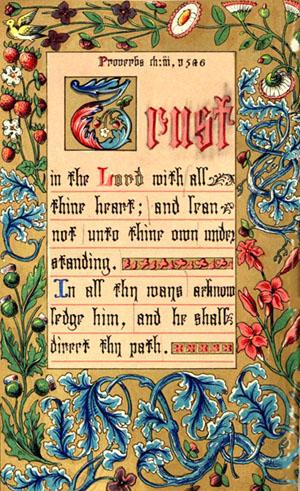
JUST PUBLISHED.
LAURENT DE LARA'S
SHAKSPERIAN PROVERBS,
FROM HIS PLAYS.
Quarto Imperial, price 1s. 6d. Plain; 3s. Partly Coloured.
1. All the World's a Stage.
2. Rich Gifts wax Poor.
3. Suspicion always Haunts.
4. Fast Bind, Fast Find.
5. Sweet are the uses of Adversity.
6. There is no Vice so simple.
7. Virtue itself turns Vice.
8. Come what, come may, Time.
9. O it is excellent to have a Giant's strength.
10. There's a Divinity that shapes our ends.
11. One Touch of Nature makes the whole World kin.
12. Life's but a walking Shadow.
3. Shakspere "In Memoriam," with Vignette Portrait. 2s. and 3s. 6d.
4. The Christian Martyr. "Be thou faithful," &c. With Photograph, 2s. plain; 3s. 6d. partly coloured.
CROSSES.
1. No Cross, No Crown, &c. Imperial 4to, 14½ by 10½, 1s. 6d. plain; 3s. partly coloured.
2. Take up thy Cross and follow me. 18 by 7½, 1s. 6d. plain; 3s. partly coloured.
The Parables of Our Lord.
A Selection of the most striking Parables from the four
Gospels, richly illuminated on every Page by Henry Noel
Humphreys. In rich binding, in high relief, imitative of
carved ebony, 21s.
The Miracles of Our Lord.
Being a Selection from the Miracles of our Saviour, richly
illuminated with appropriate borders of original design on
every page, and 6 illuminated miniatures by Henry Noel
Humphreys. In a carved binding of appropriate design, 21s.
Maxims and Precepts of the Saviour.
A Selection of the most striking Aphorisms and Moral Precepts
of the Saviour, richly ornamented with decorative borders
of appropriate design by Henry Noel Humphreys, founded
on the passage, "Behold the lilies of the field," &c. In an
ornamental cover of novel character, after the Style of the
famous "Opus Anglicum" of the 9th and 10th centuries. 21s.
Sermon on the Mount.
Gospel of St. Matthew, illuminated by F. Lepelle de Bois-Gallais.
Printed on plates of Silver with Landscape, illustrative
Vignettes, and illuminated borders. Square 18mo,
bound, 21s.
The Book of Ruth,
from the Holy Scriptures. Enriched with coloured borders.
The illuminations arranged and executed under the direction
of H. Noel Humphreys. In embossed leather cover, square
fcap. 8vo., 21s.
The Good Shunammite.
From the Scriptures—2 Kings, chap. IV. vv. 8 to 37. Square
fcap. 8vo. With Six original designs, and an ornamental
border to each page, printed in Colours and Gold. In carved
binding, 21s.
Sentiments and Similes of Shakspeare.
Illuminated by H. N. Humphreys. New Edition, square 8vo,
in massive carved binding, 21s.
LONDON:
LONGMAN, GREEN, LONGMAN, ROBERTS & GREEN.
THE
Albert Lithographic Printing Office,
Established to promote Female Employment,
168, GREAT PORTLAND STREET, OXFORD STREET,
LONDON, W.
E. FULLER & CO.,
ARE PREPARED TO EXECUTE
Every description of Chromo-Lithography,
ALSO
COPPER-PLATE & LETTER-PRESS PRINTING,
WITH PROMPTNESS AND DESPATCH,
At Twenty per Cent. lower than any other House.
1000 CIRCULARS ON GOOD PAPER FOR 21s.
Lithographic Fac-simile Circulars, and all kinds of Commercial Printing
EXECUTED FOR THE TRADE ON LIBERAL TERMS.
The artistic Branch of Lithography wholly carried out by Females.

With Illustrations in Outline as Copies for the Student.
BY D. LAURENT DE LARA,
(Illuminating Artist to the Queen.)
Seventh Edition,
WITH CONSIDERABLE ENLARGEMENTS AND ADDITIONS.
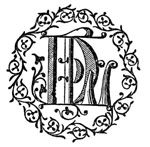
"Ingenuas didicisse fideliter artes
Emollit mores, nec sinit esse feros."
LONDON:
LONGMAN, GREEN, LONGMAN, ROBERTS, AND GREEN,
PATERNOSTER ROW.
AND ALL BOOKSELLERS.
Price Three Shillings.
The Author reserves the right of translation to himself.
LONDON:
PRINTED BY J. WERTHEIMER AND CO.,
CIRCUS PLACE, FINSBURY CIRCUS.
Madam,
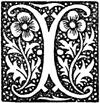 IRRESPECTIVE of the honor your
Ladyship confers on me, by allowing
the privilege of associating your
name with this edition, a nobler motive
which actuated your generous sanction, viz., "the
high interest you feel in the revival of an obsolete
but noble art," and of which you are at once its
zealous Patroness, and its more than accomplished
votary, are claims on my gratitude, which words
scarcely can express, even in the hackneyed terms
the humble sometimes venture to address to rank!—Appreciating,
therefore, deeply the distinction you
thus confer on one of your fellow-labourers in art,
IRRESPECTIVE of the honor your
Ladyship confers on me, by allowing
the privilege of associating your
name with this edition, a nobler motive
which actuated your generous sanction, viz., "the
high interest you feel in the revival of an obsolete
but noble art," and of which you are at once its
zealous Patroness, and its more than accomplished
votary, are claims on my gratitude, which words
scarcely can express, even in the hackneyed terms
the humble sometimes venture to address to rank!—Appreciating,
therefore, deeply the distinction you
thus confer on one of your fellow-labourers in art,
Allow me,
Madam,
To remain with profound respect,
Your Ladyship's devoted
and obliged servant,
D. Laurent de Lara.
3, Torrington Square, October, 1863.
| Page. | |
| Preface | 7 |
| Preface to the Sixth Edition | 9 |
| Introduction | 11 |
| On Illumination | 17 |
| General Rules | 25 |
| On Colours:—Ultramarine Blue—Vermilion—Emerald Green—Cobalt Blue—Purple—Orange Chrome—Chrome Yellow— Carmine, plain and burnt—Hooker's Green—Burnt Sienna— Lamp Black—Middle Tints—Enamel White—Platina and Silver—Green or Yellow Gold—The Agate | 30 |
| On the Arrangement of Colours | 47 |
| On Composition | 52 |
| On Preparing the Vellum | 59 |
| On Tracing and Transferring | 61 |
| On Raised Gold Ornamentations | 64 |
| Conclusion | 67 |
| On Outlines | 78 |
| List of Colours | 82 |
| Plates | 83 |
| Appendix | 83 |

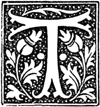 TWO years sufficed to exhaust the sixth
edition (the first shilling one) of my
"Elementary Instruction on Illuminating,"
in opposition, too, of a rival
author; who was, however, more fortunate—for he
was enabled to illuminate the world, with seven consecutive
editions in as many months, and left the world
for two years after in as much darkness as ever.—Far
from envying him this inordinate success, I rest secure
on my laurels, humble though they be.—Ten years were
needed to bring forth my seventh edition, and here it
is—as unpretending as ever—but fully understood,
and understandable—no new theories erudite in
print and bad in practice—no old ones, filched from
musty manuscripts, alike impracticable as complicated,
and displayed with learning and research, to bolster
up repute and attach importance to very questionable
utility; wholly unimportant to those who seek information.
8
I address the few and the few only, who
will take practical hints, from a practical man, clothed
in the plainest English. I do not trade on other men's
brains, but endeavour to live by my own. Those who
encourage the empiric in art must buy experience,
and be contented with their shillings worth.(?) I
have added only some additional matter on colours
and composition, as applied to illumination, which I
hope the public may find useful—in other respects
the seventh edition is like its predecessors—a
claimant to public favour.
TWO years sufficed to exhaust the sixth
edition (the first shilling one) of my
"Elementary Instruction on Illuminating,"
in opposition, too, of a rival
author; who was, however, more fortunate—for he
was enabled to illuminate the world, with seven consecutive
editions in as many months, and left the world
for two years after in as much darkness as ever.—Far
from envying him this inordinate success, I rest secure
on my laurels, humble though they be.—Ten years were
needed to bring forth my seventh edition, and here it
is—as unpretending as ever—but fully understood,
and understandable—no new theories erudite in
print and bad in practice—no old ones, filched from
musty manuscripts, alike impracticable as complicated,
and displayed with learning and research, to bolster
up repute and attach importance to very questionable
utility; wholly unimportant to those who seek information.
8
I address the few and the few only, who
will take practical hints, from a practical man, clothed
in the plainest English. I do not trade on other men's
brains, but endeavour to live by my own. Those who
encourage the empiric in art must buy experience,
and be contented with their shillings worth.(?) I
have added only some additional matter on colours
and composition, as applied to illumination, which I
hope the public may find useful—in other respects
the seventh edition is like its predecessors—a
claimant to public favour.
D. L.


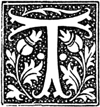 THE steady revival of the "Art of Illuminating"
during the last few years, and the
rapid progress it has made amongst the
educated classes, even since the fifth
edition of this work was published in 1859 (all the
copies of which are now sold), has induced me to re-publish
it, under the present less expensive form, in
order to keep pace with the many publications which,
under the names of "Manuals," "Primers," "Treatises,"
"Guides," and "Instruction Books," have lately
been forced on the public notice, each pretending to
give the desired information to the followers of this
beautiful art, with more or less display of talent; but
all tending towards the cultivation of a highly interesting
pursuit, and proving that the nineteenth
century may in future history be distinguished as
having produced a "style" of its own, and identifying
it with the happy and peaceful reign of "Victoria,"
10
under whose mild rule, arts and civilization are so
eminently flourishing. The perusal, however, of these
various publications has confirmed me in the conviction,
that, for the purposes of instruction, the plan
originally carried out by me was best fitted to achieve
the object in view, my aim being to instruct in, and
not to lecture on the art. I have, therefore, studiously
divested the present publication of technicalities, or of
any attempt to display learned research, in the origin
or progress of the art, which, to the uninitiated, would
not be instructive, and could only prove "caviare to
the general." My long professional experience as a
practical artist, has induced me to clothe, in the
plainest language, the information I wished to convey;
and, in common English, endeavour to speak to the
understanding of my readers. If, therefore, the present
volume prove continuously useful, as it has hitherto
been, my readers will absolve me from blame or
egotism, in thus adhering to my original plan; my care
having been not to fall into the error of my contemporary
imitators. All I have ventured to add, is
such information as my continued practical experience
has enabled me to collect, and I cheerfully communicate
it to my readers.
THE steady revival of the "Art of Illuminating"
during the last few years, and the
rapid progress it has made amongst the
educated classes, even since the fifth
edition of this work was published in 1859 (all the
copies of which are now sold), has induced me to re-publish
it, under the present less expensive form, in
order to keep pace with the many publications which,
under the names of "Manuals," "Primers," "Treatises,"
"Guides," and "Instruction Books," have lately
been forced on the public notice, each pretending to
give the desired information to the followers of this
beautiful art, with more or less display of talent; but
all tending towards the cultivation of a highly interesting
pursuit, and proving that the nineteenth
century may in future history be distinguished as
having produced a "style" of its own, and identifying
it with the happy and peaceful reign of "Victoria,"
10
under whose mild rule, arts and civilization are so
eminently flourishing. The perusal, however, of these
various publications has confirmed me in the conviction,
that, for the purposes of instruction, the plan
originally carried out by me was best fitted to achieve
the object in view, my aim being to instruct in, and
not to lecture on the art. I have, therefore, studiously
divested the present publication of technicalities, or of
any attempt to display learned research, in the origin
or progress of the art, which, to the uninitiated, would
not be instructive, and could only prove "caviare to
the general." My long professional experience as a
practical artist, has induced me to clothe, in the
plainest language, the information I wished to convey;
and, in common English, endeavour to speak to the
understanding of my readers. If, therefore, the present
volume prove continuously useful, as it has hitherto
been, my readers will absolve me from blame or
egotism, in thus adhering to my original plan; my care
having been not to fall into the error of my contemporary
imitators. All I have ventured to add, is
such information as my continued practical experience
has enabled me to collect, and I cheerfully communicate
it to my readers.
3, Torrington Square, October, 1860.

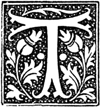 THE beautiful "Art of Illuminating,"
which sprang up with the early dawn
of Christianity, and attained its highest
perfection in the fourteenth and fifteenth
centuries, owes its total extinction to that
powerful instrument of modern civilisation, the
Printing Press. Whether it be the phlegmatic Dutch
Coster, or the German Necromancer, Guttenberg,
who was the first inventor of "moveable type," I
know not; but it is quite certain that the "printing
process" struck a fatal and decisive blow to "illuminated
painting," the relics of which at present are
carefully hoarded up in our Museums and Public
Libraries, and are at once the living and imperishable
oracles of the bygone ages of romance and chivalry,
and form the glorious monuments of the known and
unknown artists who created them! It is equally
true, as well as curious, that to another mode of
printing (chromo-lithography) the present century is
12
indebted for the partial revival of this beautiful art,
since the many publications from the lithographic
press have engendered a corresponding taste with the
public for its cultivation, which is daily increasing.
That taste is now so manifest, and so general
amongst the higher and middle classes, that it can
no longer be considered as a mere "fashionable"
pursuit, subject to the capricious ebb and flow of the
tide of fashion, and again to be doomed to pass into
oblivion. I believe a healthier motive is apparent in
its cultivators; and the desire of re-instating it to the
rank it once held amongst its sister arts is not
unmixed with the holier emotions which a genuine
religious feeling, arising from the daily contemplation
of the divine truths of Holy Writ (as exhibited in the
study of our finest missals), is capable of producing.
In this respect, it presents itself to the devout mind
of the novice as a labour of love, for the glorious
poetry of the Bible offers such a singularly fertile
source, to which the imagination and pencil may look
for artistic inspiration.
THE beautiful "Art of Illuminating,"
which sprang up with the early dawn
of Christianity, and attained its highest
perfection in the fourteenth and fifteenth
centuries, owes its total extinction to that
powerful instrument of modern civilisation, the
Printing Press. Whether it be the phlegmatic Dutch
Coster, or the German Necromancer, Guttenberg,
who was the first inventor of "moveable type," I
know not; but it is quite certain that the "printing
process" struck a fatal and decisive blow to "illuminated
painting," the relics of which at present are
carefully hoarded up in our Museums and Public
Libraries, and are at once the living and imperishable
oracles of the bygone ages of romance and chivalry,
and form the glorious monuments of the known and
unknown artists who created them! It is equally
true, as well as curious, that to another mode of
printing (chromo-lithography) the present century is
12
indebted for the partial revival of this beautiful art,
since the many publications from the lithographic
press have engendered a corresponding taste with the
public for its cultivation, which is daily increasing.
That taste is now so manifest, and so general
amongst the higher and middle classes, that it can
no longer be considered as a mere "fashionable"
pursuit, subject to the capricious ebb and flow of the
tide of fashion, and again to be doomed to pass into
oblivion. I believe a healthier motive is apparent in
its cultivators; and the desire of re-instating it to the
rank it once held amongst its sister arts is not
unmixed with the holier emotions which a genuine
religious feeling, arising from the daily contemplation
of the divine truths of Holy Writ (as exhibited in the
study of our finest missals), is capable of producing.
In this respect, it presents itself to the devout mind
of the novice as a labour of love, for the glorious
poetry of the Bible offers such a singularly fertile
source, to which the imagination and pencil may look
for artistic inspiration.
The seductiveness of the art, too, on which the meanest capacity can employ itself, is another incentive, which will cause many to venture on so pleasing an occupation. The interesting question then arises: What probable results are likely to follow from this general revival of an obsolete art? 13 My answer is, "That modern civilisation will adapt it to our modern wants, and will gradually lay the foundation of forming a new school, identical with the nineteenth century." To attain this end, conscientious artists only can pave the road; they have it in their power to direct and guide the masses, and the public is sure to go with them.
The Illuminating Art Union of London, in its annual expositions, invites artists to exhibit their productions, by which others less gifted may be incited to follow their example. True Genius, however exalted, does not feel itself above instructing others, as long as through the medium of its productions the very best interests of the art are likely to be promoted. Gradually, these productions will develop new ideas, new resources, and features of originality, in addition to the improvements which modern civilisation and modern appliances necessarily suggest. Already three prizes have been awarded for original designs of the "Beatitudes"; and, as a first essay of a young Society, they are eminently creditable. The highest in the land, and, perhaps, the humblest also, are its members and supporters; and however the effort to increase its strength and its popularity might have been thwarted, by the lukewarmness of those professedly the most interested in the art, we owe it a debt of profound gratitude, for the real 14 good it has already achieved, and cheerfully join our wishes for its welfare and success in what it still hopes to accomplish.
A tendency to undermine the best interests of the art is, however, insidiously at work to misguide the public taste. The hired pen of the unprincipled and unskilful scribbler has been used by mere traders, to advertise their own materials, and bring into notice worthless designs for illuminating; the former without the slightest regard to their adaptability for the purposes of "missal painting," and the latter without the least pretence to artistic merit. Unscrupulous authors have been found to dictate "rules" for instruction, when, practically, they require instruction themselves, judging from the ignorance they display in their own pages. These very books, miscalled "Guides" and Outlines, facetiously named "Useful Models," have received, in their turn, fulsome praise in the pages of those, whose talents (to their shame be it written) as illuminators are unquestionable, and whose commendations, though valuable (?) in a trading sense, are sadly detrimental to the interests of those who seek for information and instruction.
It is, however, to be hoped that a discriminating public, whose taste in Missal Painting and Illuminating has become considerably enlightened and developed of late years, by the daily contemplation of, and 15 familiarity with, the works of our greatest masters, (owing to the great liberality displayed by the trustees of the British Museum, in throwing open, without reserve, for daily inspection, the glowing vellums contained in its various collections, together with the publication of such immortal works as the "Hours of Anna Brittanny" published in Paris, etc., etc.) will be enabled to discern the useful from the worthless, and separate the gold from the dross.

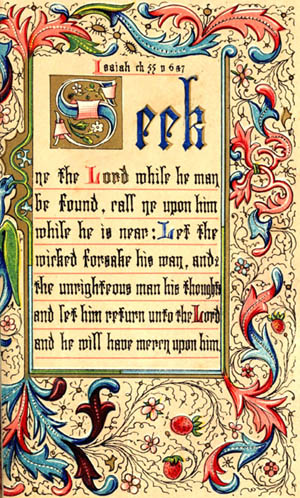

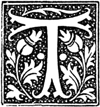 THE necessity for an "Elementary Instruction
Book," to acquire the art of
illuminating on vellum, for the use of
those who are desirous of practising
this beautiful and graceful accomplishment, has
long since become imperative; particularly since, to
my own knowledge, several handbooks have made
their appearance, professedly with the object of
affording instruction to the many amateur artists, who
eagerly seek for such information in the first one
that is presented to them by the bookseller; and it
often happens, that such books, by their high sounding
titles, deceive both the vendor and purchaser.
The subsequent disappointment to the latter may be
easily imagined, when, instead of the "instruction"
anxiously looked for, he finds an elaborate treatise
"cut short" on the plea "of the necessary limits of the
little work," etc; and then only obtains snatches of
information of extraordinary existing specimens to be
18
found in the various libraries of Europe, to which
he can have no access; interlarded with "technical
phrases," of which he can have no idea, and elaborate
fragments of ornamentation, illustrative of the author's
text, but without affording him the slightest clue what
to do with them, or how, in his experience, he can
apply them to a useful purpose. The disappointed
amateur artist, therefore, turns away and feels himself
sadly at a loss for some aid in his endeavour to pursue
a most beautiful, and, at the same time, easy
accomplishment, simply from the fact of unexplained
difficulties having been thrown in his path; for
though specimens of illuminations have from time to
time been published, from which the student may
have derived some slight advantage,—if only a superficial
insight into style and taste,—yet they are universally
of too elaborate a character to be of much utility
to the beginner; and in the attempt to copy such
specimens as Noel Humphreys has published in his
"Illuminated Books of the Middle Ages," the pupil
frequently must become embarrassed by the intricacy
of the design; and not knowing any method where
to commence or how to proceed, would, in attempting
such specimens, make such signal failures, that in
despair he would throw his work aside, and for ever
abandon an art, which, simple and highly interesting
in itself, would by him be considered at once as futile
and impracticable.
THE necessity for an "Elementary Instruction
Book," to acquire the art of
illuminating on vellum, for the use of
those who are desirous of practising
this beautiful and graceful accomplishment, has
long since become imperative; particularly since, to
my own knowledge, several handbooks have made
their appearance, professedly with the object of
affording instruction to the many amateur artists, who
eagerly seek for such information in the first one
that is presented to them by the bookseller; and it
often happens, that such books, by their high sounding
titles, deceive both the vendor and purchaser.
The subsequent disappointment to the latter may be
easily imagined, when, instead of the "instruction"
anxiously looked for, he finds an elaborate treatise
"cut short" on the plea "of the necessary limits of the
little work," etc; and then only obtains snatches of
information of extraordinary existing specimens to be
18
found in the various libraries of Europe, to which
he can have no access; interlarded with "technical
phrases," of which he can have no idea, and elaborate
fragments of ornamentation, illustrative of the author's
text, but without affording him the slightest clue what
to do with them, or how, in his experience, he can
apply them to a useful purpose. The disappointed
amateur artist, therefore, turns away and feels himself
sadly at a loss for some aid in his endeavour to pursue
a most beautiful, and, at the same time, easy
accomplishment, simply from the fact of unexplained
difficulties having been thrown in his path; for
though specimens of illuminations have from time to
time been published, from which the student may
have derived some slight advantage,—if only a superficial
insight into style and taste,—yet they are universally
of too elaborate a character to be of much utility
to the beginner; and in the attempt to copy such
specimens as Noel Humphreys has published in his
"Illuminated Books of the Middle Ages," the pupil
frequently must become embarrassed by the intricacy
of the design; and not knowing any method where
to commence or how to proceed, would, in attempting
such specimens, make such signal failures, that in
despair he would throw his work aside, and for ever
abandon an art, which, simple and highly interesting
in itself, would by him be considered at once as futile
and impracticable.
19 The beauty of illuminated drawing consists chiefly in the nicety of execution, elaborate ornamental detail, and the mathematical precision with which ornaments are frequently repeated throughout the same design. The arrangement of colours requires also much judgment and taste, whilst the knowledge how to lay them on evenly and smoothly, requires the practical instruction of the teacher, without whom it is almost impossible to overcome these difficulties, or acquire proficiency, particularly in raised gilding, and the nicety which is required in using the agate, with which the ornamentations are engraved on matted gold or silver.
As an art, which originated at the remotest period of Christianity, and which originally was practised by very limited artistic intelligence, its first development was exceedingly simple, crude, and grotesque. When the rolled papyrus manuscripts were superseded by squares of parchment, in the form of our present books, the Scribes or Monks of the early Christian period were the first who were engaged in the writing of prayer-books or missals for the wealthier classes of people, who at that time were alone enabled to indulge in the luxury of a book; it is then we find the first germs of artistic composition displayed, in the initial letters which began to be conspicuously large and ornamental, fanciful, and sometimes intricately and ingeniously contrived, in contradistinction 20 to the older rolled manuscripts discovered in Herculaneum and Pompeii, in which no traces of ornamentation could be found. From this simple source of artistic development, we may contrast the productions of Giulio Clovio of a much later period, and his many and unknown contemporaries, who have astonished the world by productions, unequalled by anything that modern art could achieve. As I shall have occasion to speak of the progress of illuminating, and ornamental art, in a separate work about to be published, I merely hint here, at the commencement, that, for modern purposes of illumination, it would be highly pedantic to copy the earlier productions of missal painting, merely because they are antique, if in other respects they do not possess some artistic quality of graceful development both in outline and colouring, to which the modern artist may, with very good taste, give preference.
The object of this little work is not so much to enter into any detailed history of the progress of ornamental art, which may well become a separate and intricate study, as to smooth down the difficult path of the beginner, to unravel for him apparent mysteries in the art, to give him examples of practical designs to imitate from, suitable to his skill; to point out to him clearly and unmistakeably such rules as, from my experience, I have found absolutely necessary to adopt, and which if studiously followed up will, 21 in a great measure, assist his first efforts and enhance his ultimate success and proficiency.
That which is most remarkable in those mediæval vellum-illuminations which have been preserved in the various collections of Europe, is the brilliancy of their colours, tints unsurpassed by anything that our modern contrivances can equal, or our colour-box approach. Specimens which have stood the test of a thousand years' duration, are as fresh and as brilliant as if they came newly from the artist's hands. Such orange, and such greens, and purples, as if directly snatched and stolen from the rainbow itself, or distilled from the prismatic rays of a benignant sun. The borders are actually studded with gems of colour which sparkle on the insects as if they were photographed from nature, colours as well as form. Drapery, damask, armoury, furs, and feathers, are all portrayed in such rich and gorgeous tints, that we may well doubt whether the secret of these colours has not died with those who used them centuries ago. Our water-colours were as brickdust at the side of them. In order somewhat to remedy the deficiency of our colours (as I found them) in comparison with what was desirable, the attempt has been made to manufacture them on a new principle, in order to preserve all the brightness of the chief tints predominant in illuminations; and I am happy to say, that, after years of experience, I have entirely succeeded in 22 producing a set of colours suitable for the purposes of illumination; and I now beg to recommend to my pupils and readers those only called "Illuminating Colours." Chemically speaking, they are manufactured on a totally distinct principle from other water-colours, and are made to answer all the purposes of illuminated drawing, affording perfect facility on the one hand in laying them on evenly and smoothly, and, on the other, saving a great deal of time and labour, and enhancing much the general effect of the design, in the brilliancy of the tints; this refers more particularly to their use when applied to vellum, which from its greasy surface is apt to reject the usual water-colours, whilst those of the illuminating-box are found perfectly to answer the purpose. I beg also to recommend the "water gold-size," which in its application to the drawing, can be raised considerably above its surface, assuming all the appearance of being embossed, and can be immediately gilded over, which greatly expedites the process over that of any other gold varnish.[A]
That persons having a knowledge of drawing can and will make better illuminators than those who have not, there can be no doubt; and the more accomplished the artist, the better illuminator he will make is also obvious. Yet the art of illumination may be practised by persons who may be but indifferent 23 artists in general design, and with a great deal of success; whilst others, conversant with the highest principles of art, have frequently been found to be but very indifferent illuminators. The reason of this is apparent; illuminating being for the most part a strictly mechanical art (though subject to artistic principles), any one possessed of natural gifts of taste, patience and perseverance, will, by studiously following out some slight mechanical contrivances, easily attain the first principles primarily necessary to copy any given outline however intricate; not even excluding the human figure.
The ornamental arabesque scroll, from its primitive simplicity to the most elaborately finished foliage, interlaced initials, etc., are given in due succession for the pupil to copy; by which means his hand becomes gradually trained to curval delineations, and his eyes get by degrees educated, till at last all angular tendency in his ornamentations is entirely eradicated. Once trained to that perfection, colouring and shading become comparatively easy, and a little instruction, with practice, will enable the hitherto uneducated artist to overcome almost every obstacle. The free-hand artist, on the other hand, relying on his capacity alone, and disregarding the mechanical contrivances at his command, not unfrequently stumbles over the easiest parts, pettishly condemns all such appliances, the neglect of which destroys the 24 uniformity and mathematical precision of his work, and finally he leaves off, disgusted with his ill success.
I would, therefore, recommend first of all to the pupil to provide himself with a box of Illuminating Colours, which can be obtained of the author, or at any of the authors agents, which also includes compasses, parallel rule, ruling-pen, agate, gold, etc., and other little but indispensable tools; without which the student would be at a loss to proceed. Having procured these, I would then place this book in his hand, and, by following up the rules laid down here he will find himself, at least, enabled to make such progress, that, with the aid of one or two courses of instruction from a proper and experienced artist, he will completely overcome those difficulties which it would be vain to struggle against by himself. The manuscript room in the British Museum, to which, on a proper recommendation, access can be had, will finally give him an opportunity of studying the art more fully, and make him conversant with the immense store of mediæval treasures hoarded up there in endless variety and profusion.
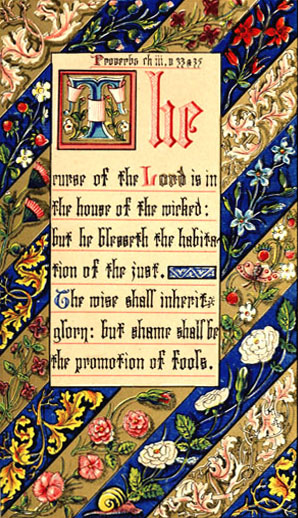

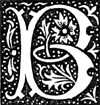 BEGINNERS should not be too ambitious;
let them be, therefore, contented
to copy first, before attempting
original designs,—it will give them
experience and method. In the higher walks of
art, copying is always resorted to; the painter
has models, casts, and drapery to guide him, and
Nature is his instructor; and let him be ever so
original, he still imitates nature. Now, since there
are no ornamentations in nature to guide our illuminating
art-student, let him be content to copy, first,
from those whose works are acceptable for their
originality, their effect, and their classical beauty.
26
The more these are studied and copied from, the
nearer the pupil will arrive at perfection, and may
gradually become an original artist himself.
BEGINNERS should not be too ambitious;
let them be, therefore, contented
to copy first, before attempting
original designs,—it will give them
experience and method. In the higher walks of
art, copying is always resorted to; the painter
has models, casts, and drapery to guide him, and
Nature is his instructor; and let him be ever so
original, he still imitates nature. Now, since there
are no ornamentations in nature to guide our illuminating
art-student, let him be content to copy, first,
from those whose works are acceptable for their
originality, their effect, and their classical beauty.
26
The more these are studied and copied from, the
nearer the pupil will arrive at perfection, and may
gradually become an original artist himself.
In commencing a subject, it is absolutely necessary first to arrange a rough design of the intended subject; to perfect a sketch, and then to make careful and correct tracings of the various parts (if the design is a subject of repetition), or the whole; to retrace them to the vellum, or Bristol board, with the red prepared paper, as faintly as is consistent with being able to see it. This is accomplished by placing the red paper between the tracing and the vellum, or drawing board, and following its outline rather briskly with a fine pointed H H H lead pencil, reversing the tracing when the ornament or border forms the counterpart of the design, which secures a perfect facsimile reversed; and, when completed, repairing any part which may be defective with the pencil, and perfecting the outline where it is uneven, or the scrollwork is broken or ungraceful. The beauty of illuminations is always best secured when the scrollwork runs gracefully smooth, not broken or angular, which gives it an awkward and unartistic appearance. In order to 27 prepare the pupil, I have given, in the illustrations, the arabesque scroll and curval lines to be drawn at the beginning in pencil only; and when form is thoroughly attained, let him re-execute it with a fine sable brush and carmine, which will give proper practice to use the brush effectually. I have adopted the arabesque scroll as the principle of all ornamental design; and I would advise the novice to practise it continually, on the same principle that exercises and scales are recommended in music to train the hand.
Referring back to the design, when the sketch is complete (which should always be as faint and delicate as possible, since it is no easy matter to erase a coarse outline from the vellum or cardboard by the usual mode of india-rubber), the process of colouring may then commence, by placing in the various compartments of the design the colours as previously arranged, somewhat in the following order, viz., first, all the blue throughout the drawing, or any portion of it intended for completion; then the vermilion, the orange, the purple, the green or yellow, and any other colour which may be in the design; next, the gold forming the outlines of the next ornamentations; and last of all, the shading of scrollwork, both gold and coloured, and also the shadings on the gold backgrounds; that being completed, you put white or gold arabesque 28 ornamentations on the ultramarine, carmine damask on the vermilions and orange, and Hooker's green or cobalt ornamentations on the emerald. After the whole has been thus far finished, the raised gold may be introduced, finishing the matted or dead gold with burnished ornamentations, dots, scrolls, arabesques, or any other design. This should be the last process of all, since the atmosphere is somewhat apt to deaden its brilliancy; and, therefore, it should be the concluding operation before the drawing is finally consigned to the frame or album. I must here also state, that if the vellum be somewhat soiled whilst the drawing proceeds (which every care should be taken to avoid, by always using a mat of blotting paper to rest the hand on), it may be rubbed over with a piece of stale bread, which will perfectly cleanse it. This process, however, must always be done before filling in the gold, silver, or platina, as it cannot be used over the gold with safety.
All straight lines, however short, should be drawn in with the ruling-pen, opening it wider or narrowing it, as the line is required to be thick or thin; if very thick, rule in two thin lines equally distant, and then fill up the intermediate space with the brush. A circle, or portion of a circle, is drawn with the bow-pen; and any portion of a curve is drawn in by the 29 aid of the wooden scroll, which is fixed on the drawing in such a position, that its curve corresponds with the outline to be ruled. The nicety of the drawing depends entirely on the execution, and the carefulness with which the details are accomplished.

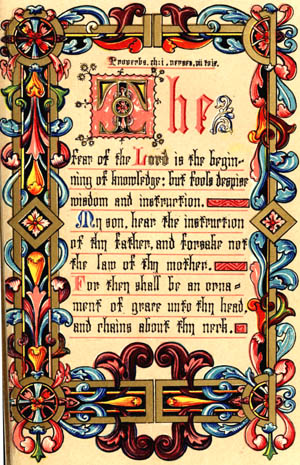

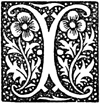 IF the observations on Colours, advanced
elsewhere, hold good, as to
their brilliancy in the mediæval missals,
the improvement which the modern
manufacturer has been able to effect is not less
apparent; for, although the mediæval productions
are mostly painted in body colours, which are
managed so exceedingly and wondrously skilfully,
with touches so light and aërial, that to the beholder
the dew-drops might almost seem capable of
being gathered from the flowers, or the "mealy" dust
brushed from off the wings of the butterfly—that furs
and feathers would almost seem to yield to the touch,
so nicely is the perception of their appearance preserved,
that one may well look with amazement, not
only at the marvellous tints themselves, which are
preserved to this day in all the brilliancy of their
pristine freshness and beauty, but also question as to
31
whether these effects were mostly attributable to the
skill of the artist, or to the quality of the body colours
themselves. Still, I am inclined to think, from general
observation and historic tradition, that the secret of
the chemical admixture of these pigments was as
much the individual secret of the artist himself, as
was his particular mode of executing his handiwork.
For it is reliably known, that the great Rubens, and
his predecessor Van Eyck, both Flemish artists, most
assiduously studied chemistry in Germany before they
applied themselves to painting; and that, to a great
extent, the brilliancy of their colours was owing to
their extensive knowledge of that science. If, therefore,
the "science of chemistry" was considered so
material a qualification in the mediæval painter, it is
not at all improbable, that the illuminator of the
period was actuated by the same motive to acquire
this knowledge, by which only his works could be
appreciated, as so much was depending on the quality
of his colours, to produce those mysterious and almost
miraculous effects, which the present age is still at a
loss to imitate. I am strengthened in this assumption
by the fact of having seen a curious old missal, in the
library and museum of the Hague, a few years ago,
attributed to Van Eyck (who is known, not only as
an illustrious painter, but also as a skilful illuminator),
in which is embodied an illumination representing a
studio, where the scribe is assiduously engaged on his
32
work, whilst an assistant is seen grinding materials on
a stone slab, and arranging them on a pallet, for the
use of the artist.
IF the observations on Colours, advanced
elsewhere, hold good, as to
their brilliancy in the mediæval missals,
the improvement which the modern
manufacturer has been able to effect is not less
apparent; for, although the mediæval productions
are mostly painted in body colours, which are
managed so exceedingly and wondrously skilfully,
with touches so light and aërial, that to the beholder
the dew-drops might almost seem capable of
being gathered from the flowers, or the "mealy" dust
brushed from off the wings of the butterfly—that furs
and feathers would almost seem to yield to the touch,
so nicely is the perception of their appearance preserved,
that one may well look with amazement, not
only at the marvellous tints themselves, which are
preserved to this day in all the brilliancy of their
pristine freshness and beauty, but also question as to
31
whether these effects were mostly attributable to the
skill of the artist, or to the quality of the body colours
themselves. Still, I am inclined to think, from general
observation and historic tradition, that the secret of
the chemical admixture of these pigments was as
much the individual secret of the artist himself, as
was his particular mode of executing his handiwork.
For it is reliably known, that the great Rubens, and
his predecessor Van Eyck, both Flemish artists, most
assiduously studied chemistry in Germany before they
applied themselves to painting; and that, to a great
extent, the brilliancy of their colours was owing to
their extensive knowledge of that science. If, therefore,
the "science of chemistry" was considered so
material a qualification in the mediæval painter, it is
not at all improbable, that the illuminator of the
period was actuated by the same motive to acquire
this knowledge, by which only his works could be
appreciated, as so much was depending on the quality
of his colours, to produce those mysterious and almost
miraculous effects, which the present age is still at a
loss to imitate. I am strengthened in this assumption
by the fact of having seen a curious old missal, in the
library and museum of the Hague, a few years ago,
attributed to Van Eyck (who is known, not only as
an illustrious painter, but also as a skilful illuminator),
in which is embodied an illumination representing a
studio, where the scribe is assiduously engaged on his
32
work, whilst an assistant is seen grinding materials on
a stone slab, and arranging them on a pallet, for the
use of the artist.
With work on hand, and, perhaps, with commissions for years, is it too much to assume, that he would never incur the additional trouble of preparing his materials, were it not that the secret of his preparations was his motive for so doing? This secret, I contend, is lost to us, and with it the character of these body-colours, which our present ones do not equal. For instance, I ask the student and observer to compare the delicacy and permanency of the white ornamentations in the works of the older masters with what our present Chinese white will effect.
Whether, in the present day, we can again produce such glowing scarlet or brilliant orange, remains a matter of doubt; but enough has been done already to make us hope that much more may be expected, in proportion as the attention of chemical science is directed to the object, and the urgency of the illuminator furnishes suggestions. I have come, however to the conclusion, that with our present appliances, we may make a tolerably good shift; and I recommend, therefore, for general purposes of the art, the "Illuminating Cake Colours" as the best, and as the safest (particularly to place in the hands of the beginner). They are capable of being used with the greatest facility, and can be worked up, with the 33 happiest effect, in shading very minute ornamentations or miniature paintings; and it would require more than ordinary skill, and a vast amount of experience, to handle "Moist Colours" equally well. How the several writers on this art can recommend them, I am totally at a loss to imagine. One colour manufacturer, in his eagerness to go with the stream, has actually produced an illuminating box with Powder Colours. I advise the unlucky purchaser to lay them by, to tint wax-flowers with, since, for the purposes of illumination, they are totally useless. The Cake Colours, from my own experience, are the only means the illuminator has to rely on, in order to give a soft tone to his work; and when mixed with the enamel white, they form opaque tints, which even then can be used with greater facility than when compounded with Moist Colours.
Half a dozen only of the Moist Colours I recommend, in addition to the Cakes, to produce finishing effects in touching up, when all the subject has been completed, or to use wholly for deep-tinted fruits or flowers, such as cherries, currants, carnations, or hearts'-ease, in which the rich, moist, purple carmine will give the happiest and quickest effects. Hooker's green, carmine, burnt carmine, purple, burnt sienna, and emerald green, will be amply sufficient for this purpose. In conclusion, I therefore warn the purchaser not to be allured by the sounding title of an "Illuminating 34 Colour-box," though highly-priced and costly fitted up, but to purchase that only which is likely and capable of answering his purpose.
I must give the present age credit for having left no means untried to supply the demand of suitable materials for the purposes of illuminating, in the hope of approaching, or even equalling, the effects displayed in the missals of the middle ages; and, as these effects vary in the originals, owing to different theories pursued by different artists, so the present systems adopted by various and eminent manufacturers in their present Illuminating Colours, are apt also to produce different results. We have then before us—Powder, Moist, Cake, and recently again a new contrivance of Liquid Colours, produced by a firm of eminent repute, and which, from my own experience, are certainly as bright and brilliant as one would wish to see—each of these possesses merits useful in its own way, provided the skill of the Artist has been able to seize on their adaptability,—but placing each of these four different kinds of colours in four equally clever hands, there will be four distinct results; thus, with our present Moist colours, we shall obtain (if we wish to imitate that) the coarsest results of the earlier productions of mediæval art, without their brilliancy, looking heavy, and wanting the transparency so charming in the better productions of the later Italian style. The Powder colours again look transparent, and 35 perhaps brilliant, but require great skill and much manipulation, to keep the shading soft, and prevent the hard line, where the colour unhappily was suffered prematurely to dry; depth of tone, too, is out of the question. The Liquid colour possesses brilliancy of tint, a perfectly flat and even appearance like enamel, depth of tone, and is most useful for flat illuminations where no shading is required; transparency, however, according to my present impressions, is wanting. Cake colours, therefore, aided here and there by the adjuncts of moist or liquid colours, as the nature of the work in hand may suggest, are, in my opinion, the best medium through which the higher qualities of finish, and the general impression which those better and unapproachable specimens of our best models leave on our mind, can be attained.
Since brightness and effect are essentials in missal painting, all the fault must not be laid at the door of the colour-box, but frequently to the unskilful manner in which they are used. It is astonishing the difference which is perceptible in the drawings of one artist and another. I have frequently had occasion to ask my pupil where she obtained that orange or this vermilion. "It is from your colour-box," would be the reply, and whilst, in another instance, I might find fault with a colour for being dingy and impure, she might have been heard to answer, that it was my own colour she had used. The fact 36 is thus quite clear, that one artist has better skill to use the colours than another; and it requires a certain knowledge and method to use them properly. From my own experience, therefore, I will give explanations how each colour should be used, for what applies to one may be totally different in another. I shall, therefore, commence with—
The Ultramarine Blue,
Which is a metallic colour of recent invention, and chiefly manufactured in Germany. The best and purest is prepared in France, and varies considerably in price and quality. It forms one of the most essential colours in illuminated painting, giving tone and life to the whole, and forming a strong contrast against any other bright colour; it should, however, not be too predominant, but judiciously introduced. It is manufactured without any component ingredient which tends to affect its brightness, or its brilliant depth. In combination with enamel white it can be tempered to any shade, resembling the pure ultramarine in tint, but of a brighter and less greenish quality. It must be laid on very evenly, very rapidly, and after once being painted in and yet moist, a full brush must immediately be used, to let an additional quantity freely and fully drop in; when dry, it will be perfectly even and equally dispersed. Gold, 37 platina, or enamel white may form graceful ornamentations over it, as also a deep black, which forms a rich contrast against the ultramarine; particularly if a bright spot of orange or carnation, such as a dot, is introduced. The drawing of any ornamentation over it should be done very finely, and with the finest brush, so as to look delicate, artistic, and studiously neat. The best mode of shading it is not with black, but with deep carmine and a little gum arabic in solution; it forms an intense purple, and is much more effective than black.
Vermilion.
The vermilion, which at all times is difficult to obtain very bright, requires to be laid on evenly and not too thin; it should not be allowed to dry before the intended space be completed, otherwise you obtain a sharp edge. The brush should be moderately full, but if too full, it will cause the colour to run towards one point, and form a dark spot. Once is sufficient to go over with the brush, if carmine ornamentations are intended to embellish it; but when a bright red only is intended, it would be better to paint over twice, always taking care to let the first wash dry first, before applying the colour a second time. Carmine should always be used to shade or ornament it, and if in some instances a deeper contrast is desirable, 38 add a little burnt carmine to it, where the greatest amount of intensity is required. Never use black to effect the object.
Emerald Green
Requires nearly the same treatment as vermilion, with a little more care in washing in a second time, since that colour is easily displaced by the second time going over it, which would give it an uneven appearance. The beauty of illuminated drawing is greatly increased by the solid and even appearance of the colours. If used faintly, it may be shaded and ornamented with cobalt; if used intensely, Hooker's green may be more effective; mixed with a little cobalt, it forms a bluish green, frequently introduced in drapery in the old missals. It is a useful and effective adjunct in scrollwork, but should not be used for the painting of natural leaves; they look then as if cut from bright green paper, instead of representing nature's variegated ornaments.
Cobalt Blue
Is used precisely as the emerald green. A thin and even wash is most essential in the first place, to be gradually tinted up with the same tint. A good deal of patience and manipulation is necessary to smooth 39 this most difficult colour into obedience. Young beginners will find it most irksome to handle, but it forms an agreeable variety amidst the other blues. It looks well for skies in tiny landscapes, and may be used for water, if copying the older missals, in which it will be seen that water is always blue. White ornamentations are used over it, to hide any defects.
Purple
Is not a permanent colour, but being in combination with another, it changes to a bluish tint; it is easily applied, and very useful and rich in contrast with orange, silver, or light colours in general. This colour has been much esteemed, as preferable to the made-purple of carmine and cobalt. It can be used for backgrounds if intensely laid on, two or three times over: it has almost the appearance of velvet, and may be used with advantage in every shade, and modified with a little burnt carmine to suit the taste of the artist.
Orange Chrome
Is not so bright as the red lead, but is permanent, and will not turn black. I have preserved all its brightness that was possible to obtain, and have, 40 therefore, entirely abandoned the more seductive red lead: it is used precisely as the vermilion.
Chrome Lemon.
Requires no particular treatment; it is both permanent and bright. We place it in the box to be occasionally used for illuminations, where an opaque colour is desirable. The gamboge can be used instead, when a transparent colour is preferable, and it will, in combination with prussian blue, form beautiful greens for foliage.
Carmine, plain, burnt, and purple.
Is one of the most useful colours in illuminations; its richness, either diluted or not, gives life and brilliancy to the surrounding colours. In combination with enamel white, it makes a rich pink; with cobalt, it forms a soft lilac; and with burnt carmine, it produces a rich brown, and invariably adds to the general effect. Carmine is so generally useful, so easily applied, that the artist will soon discover its inestimable value.
Hooker's Green
Is equally useful, brilliant, and easily applied. It 41 adds intensity to the shading of all the greens. In combination with white, a beautiful middle tint is obtained, and may be used for ornamentations, scrollwork, etc.
Burnt Sienna
Is used with the greatest advantage in shading gold or silver (particularly the former), intensified with lamp-black. It is used in figure-drawing for the hair, eyebrows, etc. In combination with burnt carmine and lamp-black, it forms a rich brown for backgrounds, and touches up foliage to much advantage.
Lamp-black
For its intensity, is preferable to Indian ink, and is very effective for backgrounds. To add to its intensity, you may mix a little gum arabic with it, when required as a shadow on the same colour.
Middle Tints
Or opaque colours, which form so conspicuous a feature in the old missals, such as pink, salmon, gray, lilac, pale green, primrose, or pale blue, are severally produced, by the addition of enamel white with the 42 following colours: carmine, vermilion,[B] black, cobalt and carmine, Hooker's green, yellow and ultramarine, in such proportion as the tint requires to be high or faint; but care must be taken in laying these on evenly to preserve an equal surface, which is easily displaced by going over it a second time.
Enamel White
Forms a distinguished feature in illuminating; its utility for various objects is apparent; a small dot, the size of a pin's point, tells on the blue, red, pink, or lilac with most delicate effect. It adds, also, a brightness to the gold and on colours, when judiciously applied. The artist can extensively avail himself of it, and may modify its intensity as circumstances require. It forms a hard enamel over the gold size, which then may be painted over with gold or silver from the shell; and when perfectly dry, may be burnished richly over with the agate, and forms a 43 bright gold or silver raised ornament. It aids him, also, to repair any damage or imperfection which may accidentally occur; and its general utility will soon be discoverable, when the student begins to advance in the art.
With respect to other colours, not enumerated here, they may be used as occasion requires; and those acquainted with water-colour painting, can apply them to the painting of flowers, landscapes, miniatures, etc., in the same manner as on drawing-board. The delicacy of vellum, however, is much better fitted for the purposes of painting than either ivory or paper; I need not add, that the most pleasing and the highest finished drawing may be successfully executed on it.
Platina and Silver.
I have adopted platina, or aluminium, in preference to silver, since the two former retain their colour permanently, whilst the silver generally discolours after two or three weeks' exposure to the air. Those who prefer the more brilliant colour of bright silver, can, however, use it; gently washing it over with a soft new brush dipped into spirits of wine (which, when dry, forms a varnish over it), thus excluding atmospheric air, and thereby effectually preventing discoloration. Care should be taken that in the process 44 the silver be not removed, by the brush being too dry or too roughly used.
Green or Yellow Gold.
The application of the green gold forms also a pleasing variety, amidst illuminations of yellow or matted gold, and gives a richness to the design, entirely unknown in the ancient missals, since its use at that period was not discovered. For this reason, many of my orthodox pupils have objected to use it, "because they could not find it in the ancient manuscripts;" but whilst I would encourage the study and close imitation of the style of the ancient masters, as far as artistic principles are concerned, I cannot object to the introduction of any improvement in effect, which modern art may suggest, merely on the ground that our productions should be slavishly imitative of the old originals. For this reason, I also always discourage the introduction of quaint and grotesque figures, mis-shapen animals and monstrosities, imaginary flowers or fruits, which never had existence, and which merely indicate a want at the time of artistic knowledge of the real beauties which are to be found in the productions of nature, the want of which knowledge, taught them to supply us with the defective creations of their untutored imaginations. Of these, plenty of specimens are found in the earlier productions of the sixth and 45 seventh centuries; they are, however, gradually improved upon in the later productions. I prefer, therefore, the pleasing consistency of representing objects of accurate design, to such as, at the present moment, would incur the ridicule and just censure of the critic. Very little observation need be made in the use of either gold, silver or platina, since it is applied easily from the shell with a paintbrush and clean water to the vellum, and can be ornamented or burnished with the agate at pleasure, or be painted over with blue, white, or red scrollwork.
The Agate
Is used, with a little practice, to great advantage, and is capable of producing beautiful effects on the shell gold. A large field of gold would look rather monotonous; the agate is, therefore, employed for engraving, as it were, little ornaments over it, of various designs, which appear in bright contrast to the dead gold. A steady hand is required to make the scrollwork run smoothly and freely; a little dot, or a cluster of them, a stalk producing little flowers, and an indented rose-leaf or vine-leaf, with its arteries, can also successfully be produced. It were best, however, to practise this on a small scale first, before progressing with the drawing in too great a hurry. I entirely disagree with the use, under any 46 circumstances, of any kind of imitation or liquid gold, firstly, because its permanency is quite uncertain; secondly, it is too coarse and brassy in appearance; and lastly, the agate could not produce the delicate tracings on its surface, as when applied to the real shell gold.


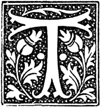 THE immense variety of styles adopted
formerly in illuminations, makes it
somewhat difficult to classify them in
this little volume; and I will, therefore,
confine myself to those which are the most
popular and the most admired. We have the
transparent border, with a profusion of scrollwork,
foliage, fruits, flowers, and insects, relieved by tre-foiled
ornamentations in raised gold, and the blank
spaces filled up with black filigree work, and which I
perform simply with the lead pencil.[C] The colours to be
arranged in such borders may be as varied as possible,
in proportion as the design consists of small and numerous
ornamentations. The contrast and variety
cannot here be too profuse, so long as they are made
with discretion. A predominance of too much blue,
or red, or green, becomes tiresome to the eye; and,
therefore, the greater number of varied tints introduced
the better. Avoid, above all, ugly colours. No olive
48
greens or bad blues, but rich and decided tints; a
deep orange, a bright red, a clear purple—against a
soft pink, a delicate primrose, or a blushing carnation;
a sky blue against a deep bronze, or chocolate brown;
the gold between, and the silver, will divide the
monotony of effects; sameness will be avoided, and
yet unity preserved. The same rule does not apply
to the solid border, where the ornamentation is
formal and large, and conspicuously relieved by a
background of solid gold or colour. A profusion of
colours then would resemble the harlequin's coat of
many shreds and patches. Simplicity, to my mind, is
its greatest merit and recommendation. I have seen
the best effects produced by the simplest means, and
by two or three colours only. Much depends on
taste, everything on effect and sound judgment; and
if, in such class of design, the object must be attained
by the quantity of colours, it proves the poverty of
the artist's resources.
THE immense variety of styles adopted
formerly in illuminations, makes it
somewhat difficult to classify them in
this little volume; and I will, therefore,
confine myself to those which are the most
popular and the most admired. We have the
transparent border, with a profusion of scrollwork,
foliage, fruits, flowers, and insects, relieved by tre-foiled
ornamentations in raised gold, and the blank
spaces filled up with black filigree work, and which I
perform simply with the lead pencil.[C] The colours to be
arranged in such borders may be as varied as possible,
in proportion as the design consists of small and numerous
ornamentations. The contrast and variety
cannot here be too profuse, so long as they are made
with discretion. A predominance of too much blue,
or red, or green, becomes tiresome to the eye; and,
therefore, the greater number of varied tints introduced
the better. Avoid, above all, ugly colours. No olive
48
greens or bad blues, but rich and decided tints; a
deep orange, a bright red, a clear purple—against a
soft pink, a delicate primrose, or a blushing carnation;
a sky blue against a deep bronze, or chocolate brown;
the gold between, and the silver, will divide the
monotony of effects; sameness will be avoided, and
yet unity preserved. The same rule does not apply
to the solid border, where the ornamentation is
formal and large, and conspicuously relieved by a
background of solid gold or colour. A profusion of
colours then would resemble the harlequin's coat of
many shreds and patches. Simplicity, to my mind, is
its greatest merit and recommendation. I have seen
the best effects produced by the simplest means, and
by two or three colours only. Much depends on
taste, everything on effect and sound judgment; and
if, in such class of design, the object must be attained
by the quantity of colours, it proves the poverty of
the artist's resources.
The partially solid border, which is a combination of the first mentioned, consisting of square, or undulated solid bands, with transparent background, should, in character and combination of colours, be also alike; modified, however, by the consideration of these solid spaces, on which the ornamentation should be simpler, and in good harmony against the colour of the background. These backgrounds are in various tints—the most common in use is gold; we 49 have also crimson, ultramarine, purple, and not unfrequently black. On all these, the taste of the illuminator is called in to produce a good contrast in the arrangement of colours, and the less confused by quantity the better.
There is another style which I have adopted, and which scrupulous antiquarians would not designate as being strictly legitimate, in which the arrangements and a profusion of contrasting colours, is allowable and even desirable. I published the class of design I allude to in the "Victoria Annual of 1844," the originals of which are in Her Majesty's possession—the chief attraction consists in the design of the initial letter, and the first word of the poem or subject, which is prominent at the head of the drawing, enclosing the remaining text in a small narrow framework, surrounded more or less by elaborate scrolls, arabesques, medallions, etc., always avoiding known and accepted mediæval ornamentations from the old missals as much as possible, in order not to mix the different styles in one drawing. This style has found much favour with modern artists, on account of its graceful effect, the absence of conventional stiffness, and the rapidity with which a composition may be arranged. Legitimists do not like it from mere affectation; they would prefer crude, ugly, misshapen ornamentation, flat and unfinished, as long as it resembled a conventional style. For 50 the same reason they object to green gold, or agate ornamentations; yet what can be more attractive than the yellow and bright green gold in combination, enriched by the artistic engravings of the agate? What more gorgeous to the eye than a display of graceful curves fantastically interwoven, enclosing highly-finished medallions, and thrown up by all the effects imagination and art can conjure up? Some of these specimens may be seen at my own gallery, and amongst them a rich specimen of a chess table which figured at the Great Exhibition in 1851, and which occupied me two years in painting. There are numerous other styles; and even modern art illuminations may be multiplied in an almost infinite variety; but the experience in such as are above alluded to, will give sufficient instruction, and regulate a classical and perfect taste, under whatever circumstances afterwards the pupil may be called upon to exercise his skill.
Within the last few weeks, I have designed and published a Series of Outlines, called the "Beauties of Shakespeare," illustrative of the poetical genius of the great bard, in which the attempt has been made to embody the poetical creations of the Poet in vignette illustrations of the text, interwoven with suitable ornamentations, light and aërial as the fleeting thoughts of the Poet himself, unencumbered by formal square borders, and avoiding all conventional ornamentations, which, strictly speaking, belong to sacred art 51 only. Six subjects from the "Tempest" form the first series, in which the songs of Ariel are surrounded by descriptive and pictorial illustrations of the text, and the choice sentiments of the chief personages in the play, such as "Prospero," "Ferdinand," and "Caliban," are duly illustrated throughout the ornamentations with pleasing and appropriate effect. Six more subjects from the "Merchant of Venice," which forms the second series, are treated similarly, and to this, the more dramatic description of the text, afforded a widely different opportunity in producing totally distinct effects, by which sameness was entirely avoided. Sufficient of ornament is, however, preserved to throw in harmony and healthy contrast of colour and gold, to keep it legitimately within the range of "illuminated illustrations." Whether the modern taste will encourage this attempt at innovation,—whether it will attract the sympathies of a new school of artists, or not,—or be condemned by the more severe and uncompromising antiquarian, experience and the success or failure of this publication will prove; if successful, the boundless wealth to be found in the pages of the illustrious dramatist, will afford ample material to follow up this publication by similar attempts in his other, and perhaps more popular plays.


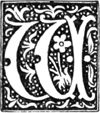 WHILST the student may profitably employ
himself in attempting minor trifles—initials,
copies of anything within
his reach, or his own ideas; to acquire
proficiency in the art, it is requisite to employ
a master to direct his taste on the one hand, and
to lead him on step by step to perfection, on the
other. It would be highly essential to him to study
the ancient missals, so as to enable him to distinguish
the progress the art has made in various countries and
in different ages. It is a field for deep research and
study, to note the different styles adopted at different
epochs, from the crude development of art of the fifth
and sixth centuries, to the refined and exquisite productions
of the Italian and Flemish schools of the
fourteenth century, and again down to the inferior
and flimsy style of Louis Quatorze. It is from the
study of these, that his own ideas will be developed
53
and improved, and that his modern notions of beauty
and effect may be advantageously thrown in, to produce
original and classical productions, abandoning that
which is absurd and meaningless, and substituting
that which is rational, effective, and beautiful. The
pedantic absurdity of retaining any class of ornamentation,
solely because it was used in the early ages by
our ancestral predecessors, on account of their notions
of drawing and perspective being imperfect, is as
rational, as it would be for the vigorous offspring of a
lame parent to use crutches and insist on walking
lamely; and whilst we may justly admire the ingenuity
of their efforts in producing the historic records of
their skill, we may, at least, elevate our taste in improving
on that which plainly bears the stamp of their
imperfections. In composing a drawing, the student
should select the style of a certain period, to which
throughout he should strictly adhere, as the adoption
of different styles in the same drawing is both inconsistent,
and evinces bad taste; to mix up the Gothic
with the Louis Quatorze, or the Elizabethan with the
Italian style, would simply be absurd. The writing of
the text, the initial letters, the ornaments, costume,
armory, etc., all should partake of the corresponding
epoch. Illustrations also should be introduced according
to the subject, and the ornamentations be
also adapted to, and harmonize with, the whole.
If, for instance, it was determined on to illuminate
54
the Creed or the Lord's Prayer, pictures might be introduced
illustrative of the lives of the Saviour and the
Apostles, historical and pictorial illustrations of the
Christian creed, etc. If a secular subject from Milton,
Shakespeare, or Byron, the same rule should be
adopted. The "Lines on a Skull" from Byron might
happily be illustrated with emblems of mortality,
whilst the numerous episodes to be gleaned from the
immortal pages of our great dramatist, Shakespeare,
furnish an almost inexhaustible spring of truth and
beauty, from which the young illuminator may draw his
subjects for illustration; great liberty being allowed for
embodying the imaginations of the poet with his own,
and affording ample opportunities and material for
the exercise of his inventive powers as an illustrator,
thereby evincing a decided stamp of reflective genius.
Above all, never attempt to illustrate a common-place
subject, or defective and puerile poetry; it is not
worth the pains of a single daub of colour.
WHILST the student may profitably employ
himself in attempting minor trifles—initials,
copies of anything within
his reach, or his own ideas; to acquire
proficiency in the art, it is requisite to employ
a master to direct his taste on the one hand, and
to lead him on step by step to perfection, on the
other. It would be highly essential to him to study
the ancient missals, so as to enable him to distinguish
the progress the art has made in various countries and
in different ages. It is a field for deep research and
study, to note the different styles adopted at different
epochs, from the crude development of art of the fifth
and sixth centuries, to the refined and exquisite productions
of the Italian and Flemish schools of the
fourteenth century, and again down to the inferior
and flimsy style of Louis Quatorze. It is from the
study of these, that his own ideas will be developed
53
and improved, and that his modern notions of beauty
and effect may be advantageously thrown in, to produce
original and classical productions, abandoning that
which is absurd and meaningless, and substituting
that which is rational, effective, and beautiful. The
pedantic absurdity of retaining any class of ornamentation,
solely because it was used in the early ages by
our ancestral predecessors, on account of their notions
of drawing and perspective being imperfect, is as
rational, as it would be for the vigorous offspring of a
lame parent to use crutches and insist on walking
lamely; and whilst we may justly admire the ingenuity
of their efforts in producing the historic records of
their skill, we may, at least, elevate our taste in improving
on that which plainly bears the stamp of their
imperfections. In composing a drawing, the student
should select the style of a certain period, to which
throughout he should strictly adhere, as the adoption
of different styles in the same drawing is both inconsistent,
and evinces bad taste; to mix up the Gothic
with the Louis Quatorze, or the Elizabethan with the
Italian style, would simply be absurd. The writing of
the text, the initial letters, the ornaments, costume,
armory, etc., all should partake of the corresponding
epoch. Illustrations also should be introduced according
to the subject, and the ornamentations be
also adapted to, and harmonize with, the whole.
If, for instance, it was determined on to illuminate
54
the Creed or the Lord's Prayer, pictures might be introduced
illustrative of the lives of the Saviour and the
Apostles, historical and pictorial illustrations of the
Christian creed, etc. If a secular subject from Milton,
Shakespeare, or Byron, the same rule should be
adopted. The "Lines on a Skull" from Byron might
happily be illustrated with emblems of mortality,
whilst the numerous episodes to be gleaned from the
immortal pages of our great dramatist, Shakespeare,
furnish an almost inexhaustible spring of truth and
beauty, from which the young illuminator may draw his
subjects for illustration; great liberty being allowed for
embodying the imaginations of the poet with his own,
and affording ample opportunities and material for
the exercise of his inventive powers as an illustrator,
thereby evincing a decided stamp of reflective genius.
Above all, never attempt to illustrate a common-place
subject, or defective and puerile poetry; it is not
worth the pains of a single daub of colour.
In arranging a subject for illumination, I should first draw my attention to the initial letter at the head of the text. There are thousands of specimens in the British Museum; and many publications of alphabets are in existence, very useful for the beginner; these may be varied, or strictly copied at pleasure.[D] Colours 55 may be changed, scrolls or foliage altered, taking care that alterations are judiciously made, and really improve the general effect. The initial letter being settled on (which should, if possible, in some manner bear on the subject-matter of the poem or episode), I would recommend next, to write the text in old English, or Church Text, each line being ruled-in equi-distant, and the capitals left blank, to be painted in afterwards; and where a word at the end of a line is so short as not to fill up close to the margin let the space be filled up with a small ornament in some colour; where a word is to be prominent, write it in gold, or red, or a different colour to the general body of the text; when the writing is completed, I would arrange the border, one side of which may be double the width of the other, 56 the bottom also wider than the top; if pictures are to be introduced, sketch out a proper framework first for their reception. These arrangements form the groundwork of the drawing; scrollwork may then be introduced, beginning at some corner, or springing from the framework of the intended picture; when that is nicely arranged, the same scroll might be repeated, upwards or sideways by transferring the tracings; the intervening spaces, if too naked, can be filled up with flowers, taking care that, in the reduction of the size of the flowers, they each shall preserve a relative proportion to the other, equal to the scale to which they are reduced; this is very essential. If any insects are introduced, this rule should also be observed. It would look very ridiculous that a butterfly, fluttering over a rose, should be as large or larger than the rose itself, or that a caterpillar should assume the size of a conger eel in proportion to the size of a heart's ease introduced in the same drawing; one's natural judgment will suggest such faults as absurd, and they should be avoided. If the border is to remain transparent, lighter ornamentations may be introduced to fill up the blanks; and finally, all the white parts may be covered by thousands of little dots, in colour and gold, taking care that in size and distance they are all alike; this last process can be effected either with the brush or fine steel pen, as best suited to the ability of the pupil; if it should be determined 57 on to fill up the blanks with a solid background of gold, the spaces need not be crowded too profusely with small details, since the filling up of the gold would become tedious. If solid, a white line of equal distance may be preserved round every object in the border: these lines should be drawn round carefully first (not too wide), and afterwards filled up solid. This white edging forms a very soft and pleasing appearance in the drawing. If the gold is closely to fill up against the scroll or flowers, you may throw a strong shadow under it on the gold, by which means the ornaments will appear to stand out in bold relief, and be very effective, taking care that the shadows are properly thrown on, and always according to the strict rules of drawing.[E] The solid part, instead of gold or silver, may also be made of a light tint, such as a pink, or light blue, or deep purple, or even black; in which case the same colours in 58 deeper tint, with solution of gum arabic may be used, this will throw up the shadow more perfectly; the solid parts should then be scrolled over with close and fine ornamentations of permanent white or gold on the black background. As the varieties of effect are so very numerous, I think it best to leave the judgment of the pupil unfettered, to suggest the varieties himself, or to consult the various specimens in the manuscript room of the British Museum. A very effective mode of painting pictorial illustrations (known by the name of Cameo painting) may also be resorted to, viz., to draw a subject for illustration or a group of figures, all in one colour, including the background, say blue, the outlines are given on the side where the light falls, in gold; on the shaded side, with a deeper blue, the lights are gradually tinted over with gold, and the shadows shaded in with darker blue. This mode of introducing pictures was very prevalent in the Italian missals of the twelfth and thirteenth centuries; and I have seen them executed in every colour, with very good effect.


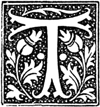 THE vellum (which should be the best
Italian, and prepared from the kid),
is of peculiarly fine and white texture,
different from parchment both in substance
and quality. I import it myself, and
previously prepare it for the artist, so that both
sides are equally good to receive the drawing upon.
Yet there is always a preferable side, which can
easily be distinguished: it is in reality the inside of
the skin, and has the smoothest appearance. The
price varies, according to the size, from 10s. to 3l.
the skin. Parchment of course is much cheaper,
and English vellum may also be had, but it does not
possess the beautiful and even quality of Italian. To
prepare it for drawing, it should be stretched on a
board made of good deal; the vellum should be cut
larger all round than the board, by about its thickness
(three-quarters of an inch), and sponged with a
60
perfectly clean sponge and water, on the side only
which is to lay against the board. When moderately
soaked, it should be laid between a fresh mangled
napkin for about five minutes, to let the vellum get
an equal moisture; the board is then placed on the
top, and the two corresponding sides are tightly
folded over, and resting it on the side, you begin to
nail from the centre, with small gimp-pins, till one
side is completed, each pin to be about one inch and
a half apart. You then do the same operation on
the other side, previously stretching it slightly and
evenly with the hand, and then again fixing the pin,
from the centre till the second side be completed.
You then again lay the board flat on the napkin, and
fold the two ends over as before, and complete the
stretching of the vellum in a similar manner. You
will then have only the back of the drawing-board
uncovered by the vellum. Let it gradually dry when
it will lie perfectly smooth and unwrinkled; and it
is then ready to work upon.
THE vellum (which should be the best
Italian, and prepared from the kid),
is of peculiarly fine and white texture,
different from parchment both in substance
and quality. I import it myself, and
previously prepare it for the artist, so that both
sides are equally good to receive the drawing upon.
Yet there is always a preferable side, which can
easily be distinguished: it is in reality the inside of
the skin, and has the smoothest appearance. The
price varies, according to the size, from 10s. to 3l.
the skin. Parchment of course is much cheaper,
and English vellum may also be had, but it does not
possess the beautiful and even quality of Italian. To
prepare it for drawing, it should be stretched on a
board made of good deal; the vellum should be cut
larger all round than the board, by about its thickness
(three-quarters of an inch), and sponged with a
60
perfectly clean sponge and water, on the side only
which is to lay against the board. When moderately
soaked, it should be laid between a fresh mangled
napkin for about five minutes, to let the vellum get
an equal moisture; the board is then placed on the
top, and the two corresponding sides are tightly
folded over, and resting it on the side, you begin to
nail from the centre, with small gimp-pins, till one
side is completed, each pin to be about one inch and
a half apart. You then do the same operation on
the other side, previously stretching it slightly and
evenly with the hand, and then again fixing the pin,
from the centre till the second side be completed.
You then again lay the board flat on the napkin, and
fold the two ends over as before, and complete the
stretching of the vellum in a similar manner. You
will then have only the back of the drawing-board
uncovered by the vellum. Let it gradually dry when
it will lie perfectly smooth and unwrinkled; and it
is then ready to work upon.


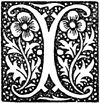 IF a copy is to be made of any illumination,
the easiest mode is by affixing
a piece of French tracing paper on the
back of the drawing, and throwing it
over the front; begin with a fine-pointed H H H
pencil, to draw an accurate outline of the whole
thin, pale and delicate. Above all things, be correct;
do not trace more than is necessary for
your object, and avoid details, which may more easily
be put in by the eye. Too much tracing often confuses.
The upper and inner line of the hair, the eyebrows,
the line of the nose, the upper line of each eyelid,
the central line of the mouth, and the contour of
the cheek and chin, is sufficient to give a correct
tracing of a face; if you trace more, in retracing
it you will get confused. With ornamentations the
same rule applies; trace only as much as will
secure your object. When your tracing is complete,
62
unfasten it, and attach it by two spots of
gum to the back of the drawing-board or vellum
prepared to receive it, and placing the red prepared
paper between it (with the prepared side towards
the board or vellum), you trace over it with the
same pencil (using a little pressure), and you then
obtain a fine, thin, delicate and faint red tracing
on the vellum. In this operation, in order to
work cleanly, the following rules must be observed.
You should use a fine H H H sharp-pointed pencil;
you should not press hard to make the transfer too
red, nor should your pencil-tracing in the first instance
be otherwise than light; it becomes deeper
when the pencil goes over it a second time, which
avoids the necessity of lifting up the paper, to
ascertain where you have or have not been over.
A good, correct and delicate transfer makes it pleasurable
to paint; a coarse deep red one gives the
artist an infinite deal of trouble, and the drawing
in this case will always look smeared and dirty,
which with a little attention can easily be avoided.
As the prepared red paper cannot always be easily
obtained, it is much easier to prepare it yourself,
which is done as follows: Purchase at the chemist's
a quarter of a pound of red French chalk, scrape
some with a table-knife on the thinnest white writing
paper you may have handy, and with a piece of
wadding rub it equally over the surface, taking care
63
that the other side is kept perfectly clean; no grease
or water should be used in this operation. Should
a pencil tracing be preferred, blacklead may be used
instead of the chalk.
IF a copy is to be made of any illumination,
the easiest mode is by affixing
a piece of French tracing paper on the
back of the drawing, and throwing it
over the front; begin with a fine-pointed H H H
pencil, to draw an accurate outline of the whole
thin, pale and delicate. Above all things, be correct;
do not trace more than is necessary for
your object, and avoid details, which may more easily
be put in by the eye. Too much tracing often confuses.
The upper and inner line of the hair, the eyebrows,
the line of the nose, the upper line of each eyelid,
the central line of the mouth, and the contour of
the cheek and chin, is sufficient to give a correct
tracing of a face; if you trace more, in retracing
it you will get confused. With ornamentations the
same rule applies; trace only as much as will
secure your object. When your tracing is complete,
62
unfasten it, and attach it by two spots of
gum to the back of the drawing-board or vellum
prepared to receive it, and placing the red prepared
paper between it (with the prepared side towards
the board or vellum), you trace over it with the
same pencil (using a little pressure), and you then
obtain a fine, thin, delicate and faint red tracing
on the vellum. In this operation, in order to
work cleanly, the following rules must be observed.
You should use a fine H H H sharp-pointed pencil;
you should not press hard to make the transfer too
red, nor should your pencil-tracing in the first instance
be otherwise than light; it becomes deeper
when the pencil goes over it a second time, which
avoids the necessity of lifting up the paper, to
ascertain where you have or have not been over.
A good, correct and delicate transfer makes it pleasurable
to paint; a coarse deep red one gives the
artist an infinite deal of trouble, and the drawing
in this case will always look smeared and dirty,
which with a little attention can easily be avoided.
As the prepared red paper cannot always be easily
obtained, it is much easier to prepare it yourself,
which is done as follows: Purchase at the chemist's
a quarter of a pound of red French chalk, scrape
some with a table-knife on the thinnest white writing
paper you may have handy, and with a piece of
wadding rub it equally over the surface, taking care
63
that the other side is kept perfectly clean; no grease
or water should be used in this operation. Should
a pencil tracing be preferred, blacklead may be used
instead of the chalk.


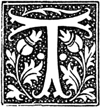 THE raised gold ornaments, which form
so brilliant a relief, amidst the gaiety
and contrast of well-arranged colours
and matted gold, are subjects which
require a great deal of practice; they should be used,
therefore, sparingly at first, on account of their difficulty,
and they should always be introduced with great
judgment, since a profusion of bright ornamentations
distracts the eye from the main subject, and becomes
extremely vulgar, resembling much that ginger bread
appearance of the French class of tinsel and emptiness;
whilst a moderate use of them, here and there,
enriches the drawing, without their effect becoming
tiresome and destructive to the general beauties of
the drawing itself. They should, therefore, be limited
to small raised dots, or tre-foiled leaves only, a line
to form a bright shadow on the dead gold, or the
arteries on a leaf of green gold. They may also form
65
a circle round a gem of ruby or emerald, representing
the setting or mounting of real gold, and such other
trifles as the subject may require. Water gold-size,
for the purpose of producing these raised ornaments,
is well calculated to effect this. The brown paste
contained in the little vessel is used in a similar
manner as a cake of water-colour, wetting it with a
sable brush, till of sufficient consistency, and painting
with it the desired ornament, and raising it by dropping
freely sufficient paste on it, which, by its own gravity,
will be properly rounded off, and becomes, when
properly set, fit to receive the gold leaf. It stands
then raised on the vellum, and may be increased ad
libitum by dropping more and more on it till sufficiently
high. In ten or fifteen minutes, at furthest,
when sufficiently set, cut a piece of gold leaf (always
a trifle larger than the object), and previously slightly
breathing on it, with the warm breath, place the cut
gold leaf on it, either with the point of a brush, or
clean scissors, or a pair of steel tongs made for the
purpose. The gold, being thus placed on the top, should
receive the warm breath again, and immediately it
will adhere firmly to the moistened matter: leave it
there for about one hour, when it will be properly
hardened; after which, with a soft clean piece of
wadding, rub it over, and the superfluous parts will
loosen easily, while those intended to be gilded will
remain. Should any part be imperfect, apply the
66
paste again as before over the imperfect part, going
through the same process till complete. This, however,
will not occur when the pupil acquires sufficient
experience of the material with which he has to work.
Another mode of raised gilding, and one which, in
my opinion, is more expeditious and less troublesome,
is effected by my "Liquid Gold Cement," which is
used in a similar manner as the "Enamel White,"
and is partly composed of the same material, with
some slight addition. You dip the brush in the
bottle, and use it rather thinly at first, whilst
delineating the ornamentation, and afterwards
drop on it (whilst wet) as much of the same as the
brush will hold, till sufficiently raised; in about
half an hour, being properly set, paint over it, in
either colour, gold or silver, and when quite dry and
hard, let the same be burnished over gently with the
crooked agate, and the ornament will stand brightly
out in the drawing; this mode I much prefer to
the former. There is still another and better method,
which I make use of in large and elaborate work, but
which I only can communicate to my pupils personally,
as it is a process that cannot possibly be
imparted in any other manner than by personal
superintendence and demonstration.
THE raised gold ornaments, which form
so brilliant a relief, amidst the gaiety
and contrast of well-arranged colours
and matted gold, are subjects which
require a great deal of practice; they should be used,
therefore, sparingly at first, on account of their difficulty,
and they should always be introduced with great
judgment, since a profusion of bright ornamentations
distracts the eye from the main subject, and becomes
extremely vulgar, resembling much that ginger bread
appearance of the French class of tinsel and emptiness;
whilst a moderate use of them, here and there,
enriches the drawing, without their effect becoming
tiresome and destructive to the general beauties of
the drawing itself. They should, therefore, be limited
to small raised dots, or tre-foiled leaves only, a line
to form a bright shadow on the dead gold, or the
arteries on a leaf of green gold. They may also form
65
a circle round a gem of ruby or emerald, representing
the setting or mounting of real gold, and such other
trifles as the subject may require. Water gold-size,
for the purpose of producing these raised ornaments,
is well calculated to effect this. The brown paste
contained in the little vessel is used in a similar
manner as a cake of water-colour, wetting it with a
sable brush, till of sufficient consistency, and painting
with it the desired ornament, and raising it by dropping
freely sufficient paste on it, which, by its own gravity,
will be properly rounded off, and becomes, when
properly set, fit to receive the gold leaf. It stands
then raised on the vellum, and may be increased ad
libitum by dropping more and more on it till sufficiently
high. In ten or fifteen minutes, at furthest,
when sufficiently set, cut a piece of gold leaf (always
a trifle larger than the object), and previously slightly
breathing on it, with the warm breath, place the cut
gold leaf on it, either with the point of a brush, or
clean scissors, or a pair of steel tongs made for the
purpose. The gold, being thus placed on the top, should
receive the warm breath again, and immediately it
will adhere firmly to the moistened matter: leave it
there for about one hour, when it will be properly
hardened; after which, with a soft clean piece of
wadding, rub it over, and the superfluous parts will
loosen easily, while those intended to be gilded will
remain. Should any part be imperfect, apply the
66
paste again as before over the imperfect part, going
through the same process till complete. This, however,
will not occur when the pupil acquires sufficient
experience of the material with which he has to work.
Another mode of raised gilding, and one which, in
my opinion, is more expeditious and less troublesome,
is effected by my "Liquid Gold Cement," which is
used in a similar manner as the "Enamel White,"
and is partly composed of the same material, with
some slight addition. You dip the brush in the
bottle, and use it rather thinly at first, whilst
delineating the ornamentation, and afterwards
drop on it (whilst wet) as much of the same as the
brush will hold, till sufficiently raised; in about
half an hour, being properly set, paint over it, in
either colour, gold or silver, and when quite dry and
hard, let the same be burnished over gently with the
crooked agate, and the ornament will stand brightly
out in the drawing; this mode I much prefer to
the former. There is still another and better method,
which I make use of in large and elaborate work, but
which I only can communicate to my pupils personally,
as it is a process that cannot possibly be
imparted in any other manner than by personal
superintendence and demonstration.

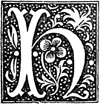 HAVING given a detailed explanation of
the mechanical means to be employed,
sufficient for the student to practise
the "beautiful art of missal painting,"
permit me to add a few words in conclusion, which I
hope will not be thought superfluous. Deeming it
essential to be as explicit as possible in the treatment
to be adopted, I have not left a single subject unnoticed,
which requires the attention of the learner.
The illustrations I have been enabled to give are
merely explanatory, but sufficient to help the pupil,
with some of the leading features observable in the
illuminations of the middle ages. For the purposes
of research, no other than the very originals ought to
be consulted, which lie within the reach of every one
to examine, at the British Museum. In that splendid
collection quite sufficient store will be found to furnish
the student with ample means of research, without
68
the necessity of travelling on the continent, though,
no doubt, a great many gems of art are to be found in
the Vatican, or the Royal Library at Paris. But
in a collection so extensive as that in our own national
Museum, or the libraries of Oxford and Cambridge, we
can find sufficient to satisfy the most fastidious and
ardent lover of art. It is essential for the student to
study originals; and I have made it a practice to accompany
my pupils at least half-a-dozen times to the
manuscript rooms, during their course of instruction,
for the purpose of calling the attention to what to him
or her is essential to know, and to afford an opportunity
of making such extracts as afterwards may
usefully avail. They then can note down the progress
of art from age to age, and the gradual development
of decorative improvement, progressive with the advancement
of civilization; yet, strange to say, though
our own age claims to have reached that, in an
eminent degree, the decorative art, as indeed arts in
general, have not progressed in the same proportion;
how to account for this, is, not that art has arrived
at its climax of excellence; but that most of its
followers of the present age have contented themselves
by strictly admiring and copying the mediæval
artist, instead of exerting their own powers to excel
him.
HAVING given a detailed explanation of
the mechanical means to be employed,
sufficient for the student to practise
the "beautiful art of missal painting,"
permit me to add a few words in conclusion, which I
hope will not be thought superfluous. Deeming it
essential to be as explicit as possible in the treatment
to be adopted, I have not left a single subject unnoticed,
which requires the attention of the learner.
The illustrations I have been enabled to give are
merely explanatory, but sufficient to help the pupil,
with some of the leading features observable in the
illuminations of the middle ages. For the purposes
of research, no other than the very originals ought to
be consulted, which lie within the reach of every one
to examine, at the British Museum. In that splendid
collection quite sufficient store will be found to furnish
the student with ample means of research, without
68
the necessity of travelling on the continent, though,
no doubt, a great many gems of art are to be found in
the Vatican, or the Royal Library at Paris. But
in a collection so extensive as that in our own national
Museum, or the libraries of Oxford and Cambridge, we
can find sufficient to satisfy the most fastidious and
ardent lover of art. It is essential for the student to
study originals; and I have made it a practice to accompany
my pupils at least half-a-dozen times to the
manuscript rooms, during their course of instruction,
for the purpose of calling the attention to what to him
or her is essential to know, and to afford an opportunity
of making such extracts as afterwards may
usefully avail. They then can note down the progress
of art from age to age, and the gradual development
of decorative improvement, progressive with the advancement
of civilization; yet, strange to say, though
our own age claims to have reached that, in an
eminent degree, the decorative art, as indeed arts in
general, have not progressed in the same proportion;
how to account for this, is, not that art has arrived
at its climax of excellence; but that most of its
followers of the present age have contented themselves
by strictly admiring and copying the mediæval
artist, instead of exerting their own powers to excel
him.
Our age is too utilitarian. The artist now merely toils to live; while, formerly, his ambition took a higher 69 flight; for then he laboured for fame and for posterity. The artist, however, who does not solely paint for gain, and who, from circumstances, is happily freed from the trammels of poverty, should strive to excel his predecessors. There is much room for improvement; modern inventions have sprung up; mechanical contrivances have advanced; new and interesting objects of natural productions have been brought within his reach, from the furthest limits of the habitable globe, to enrich the resources of his inventive powers, unknown to the antiquated monastic scribes, to whom we owe so much. Our advantages over them are obvious. Why, then, should we not excel them? Let it not be considered that this art is a mere mechanical amusement; a mere ingenious contrivance; a daub of colours and gold—showy, flimsy, and unmeaning. Though much of that exists in our modern decorations, it is highly desirable that it should not partake of that character; a little taste, a little poetry, gracefulness, order, and some display of general knowledge, of artistic combinations and principles, cannot fail to make our productions more valued and valuable. Give a tinge of some originality,—display an attempt of your own inventive powers, based upon acknowledged principles of beauty and effect, and your productions will soon reach an eminence of which art is ever capable! Though the age of romance and chivalry has gone by, and we 70 live now, strictly speaking, in that of sober reality, our artistic productions may at least show that such things have been, and may happily awaken a dream of what life once was. The study of combination and contrast of colours, affords him ample means to exercise his taste; and the eye becomes instinctively capable of discerning that which is graceful and beautiful, and that which is not. But his task is more severe than that of the painter, inasmuch as the constant demand for new ideas and effects, is a continual drain upon his inventive powers; the more these are exercised, the more original his productions, and the more likelihood there is of his excelling the mediæval artists.
It is only within the last fifteen years, that the art of illuminating has been newly revived: it has slumbered for nearly two centuries in total oblivion. I do not remember ever having seen an old missal in my younger days; so little was it considered of importance to the artist; yet what a store of information may be obtained from them! What illustrations do they furnish of the progress of the human mind and of civilization! What light do they throw on the manners, customs, and morals of bygone ages! What links do they form in the gap of historical events, which otherwise would have been left in darkness for ever! There is scarcely a page, but on which you may trace some interesting event connected 71 with the history of the period, its arts, its husbandry, its revels, its glories, or its shame!
The application of lithography for purposes of coloured printing or chromo-lithography in the last fifteen years, has done much to awaken the attention of the artist and the lovers of art to the treasures mouldering in our libraries and museums; by its aid we have been enabled to obtain copies and specimens of illuminated printing, almost perfect facsimiles of the originals. It has stimulated the artist to pursue a new track for his operations; it has infused a corresponding taste in the public mind for ornamental improvement, which has manifested itself in every branch of manufacture. The interior decorations of the House of Lords afford a striking proof. A century ago, when pigtails and cocked hats were the fashion, such a gorgeous display of ornamental grandeur would not, and could not, have been suggested.
The religious associations which suggest themselves in the study of the old missals, is an element which has proved itself sufficiently powerful to our present generation, as to induce a spirit for its revival. The English as a nation (to its credit be it said) is a truly religious one. As a sacred art, then, it is alike reconcilable with their devotional habits on the one hand, and their indefatigable industry on the other, not to grudge some spare time, to its alluring attractiveness. English ladies, of the highest rank, even, have 72 each of their hours apportioned out to some useful object. This art now takes a distinguished place amongst them, and claims a great share of their solicitude, as it affords them calm and sacred thoughts to dwell upon, and ways that may be described, in the language of the Proverbs, as "ways of pleasantness and paths of peace," and that, which is anything but frivolous or worldly—divested from the pictorial and symbolical emblems of the Romish Church—the art has enough left of holy associations, to make it harmonise with the feelings of the Protestant profession of faith without being offensive. Those possessed of sterner religious scruples can fly to the secular illustration of the poets. Our literature, so rich and so eminently descriptive, opens a wide field for the followers of this art to indulge in, thus creating another field for the artist's genius equally imaginative and interesting. Tennyson's, Longfellow's, or Moore's pages are abundantly fertile in images of beauty, to single them out as fittest for the modern illuminator. All that is required (for the interest of the art) is the formation of a good school. The Illuminating Art Union of London has made a laudable attempt to establish this; its annual exhibition opens the door and invites the public to co-operate, not so much by pecuniary support as by the aid of their contributions. Those who have the ability, and have already gained their laurels, should 73 set the example; it will add much to their popularity, and not diminish one jot of that fame their talents have already achieved. True art should not be selfish. Monopoly in art, as in corn, affects the food for the mind, as in the latter, it affects that of the body. That society, happily, is not exclusive. Though supported by the highest in the land, it co-operates with the humblest in one common labour and one common object. Rank is forgotten, so long as their association with their fellow-labourers tends to humanize the masses, which, through the means of a sacred art, is so easily effected. That its labours may be successful, that its hopes may be realized, the strenuous efforts of its promoters, and their persevering exertions, are ample guarantees that the interest of those sanguine in its success is amply secured.
The International Exhibition of 1862 (notwithstanding the factious outcry against the unfortunate building, and its hapless Architect), was conspicuously successful, on account of the marked advance Industrial Art had made, not only in the produce of foreign Exhibitors, but mostly so in that of our English artizans, as compared with that of 1851 in Hyde Park. As far as English Industry and skill was concerned—it left its unmistakable traces behind, that since our first exhibition, when England entered the lists with foreign competitors, it had at the latter attained a miraculous improvement in design, 74 which no doubt was owing to a more extended and systematical culture, and to which, the numerous "Schools of Design" now established throughout the kingdom gave rise. This improvement was so perceptible by our neighbours, that even recently a celebrated and well known French statesmen and political economist, has not scrupled to express his fears "that our English manufacturers had made such progress, that sooner or later they would displace the foreign producer, and monopolize the markets of the world!" And will it now be believed, that unquestionable as it is, that this improvement is entirely due to the more extended cultivation of Ornamental Art in this country—that the Royal Commissioners of 1862, with all their collective wisdom, with their enlarged views and former experience, and with the valuable aid of highly gifted men in all departments of Science to guide their councils, should have been short-sighted enough, peremptorily to refuse admission to any works of illumination, or decorative Art, on the meagre pretence that there was no space available for such works, which in 1851, however, were deemed of sufficient importance, and to have exercised such influence on Art manufactures in general, not only to admit them freely, but to award several first-class medals, to Artists, who then even enjoyed a European reputation! (Vide report of the Exhibition of 1851). All remonstrance which could have been 75 urged by me, against such suicidal an Act, was cut short by the curt and red tape reply—"that the Royal Commissioners having once determined on any point there was no appeal from their decision."—This closed a vexatious correspondence in December, 1861, and it was not till the following April, a short month previous to the opening of the world's fair at Kensington, that among the arrivals of some productions from Japan, one I particularly noticed to consist of an "Historical Biography," a specimen of curious Caligraphy, and embellished with artistic illuminated borders in gold and colours. It was then that I ventured to address an earnest protest against this unseemly partiality to a gentleman high in office, and well known for his well earned reputation, gained in connection with the success of the first exhibition, and to his honour, be it said, immediately on receipt of my letter, he placed himself in communication with the "National Board of Education," and had influence enough to reverse the decision which the Royal Commissioners previously had arrived at. Space was then granted (almost unlimited) for the reception of Missals and Modern Illuminations. I managed by great persuasion to induce the members of the "Illuminating Art Union of London," to send what specimens they hastily could gather together, and some fifty subjects of more or less merit were hurried to the building, and placed 76 without order, without classification, in the gallery next the great dome, amongst the Architectural designs—perhaps some thirty more from private sources, amongst which were specimens from Owen Jones, Audsley and others, were the joint and meagre contributions, which the International Exhibition of 1862 received within its walls. Unprepared and without any special object, there was not a single contributor who deserved or could lay claim to any attention from the thousands who daily visited the building. I believe the wax dolls and sewing machines gained more notoriety. Unhonoured and tacitly admitted, we were ignominiously buried in a corner—the whole collection as representing the illuminating talent of this country was a miserable failure—one solitary specimen, a beautiful little prayer book in the Austrian Court, a gem of high Art of modern Illumination was worth seeing, and worth more, as a work of Art, than all the combined skill displayed in the corner of the Architectural Gallery. Who was to blame for this egregious failure? Is it to be laid at the door of our own Artists, or to the mistaken judgment of those who had the nation's interest so much at heart and who deprived us for six months of the opportunity of preparing something specially for the occasion? Has illuminating done nothing for the manufactures of this country? Ask Bookbinders, Silkweavers, Architects, Sculptors, Decorators, and every handicraft 77 besides, in which decoration forms its chief ingredient—ask the "School of Design" whether the inspiration of its latent genius, was not derived from the impetus modern illumination has given to decorative Art in general. Is it a fair standard of what English skill might have accomplished, to judge it by the miserable refuse of stale bits of tinsel and text-writing which was exhibited there? No wonder that in all the elaborate reports which daily appeared in the "Times," not a single line was penned to the Art Illuminations of 1862—it is to be hoped that the opportunity thus lost may not be fatal to the further development of an Art, which has and still exercises such beneficial influences on our Art manufactures and civilization.


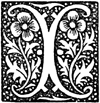 IN my first edition, in 1850, I suggested the
publication of classical outline borders,
which I only carried out in 1856, when
my second edition made its appearance;
the first part of six outlines, royal quarto,
was then produced to try how far the public would
appreciate their usefulness. The first attempt proved
a decided failure; they remained unsold, because
the uninitiated did not know how to apply them,
having no model for their guidance. I then tried
them with a small fragment, illuminated-in by hand,
which, in all cases, forms a complete key as to the
effect intended to be produced in the whole remaining
border. This met with a decided success; the
public eagerly purchased these partially illuminated
outlines; and very seldom any plain subjects afterwards
were asked for. The demand has ever since
become so extensive, that upwards of four hundred
different subjects have now been published, some
forming complete works in themselves, such as the
119th Psalm (twenty-four subjects) published by Messrs.
79
Longman and Co.; and its companion, the "Sermon
on the Mount," "The Beatitudes," etc., on the illumination
of which a large staff of lady artists are
always employed. My most anxious care was then
directed as to the choice of subjects, but above all
in the selection of the designs themselves. If, by an
extensive sale, I found myself amply rewarded, I
conscientiously felt also the importance, that the
public should receive none but choice and classical
models, from which they could study with advantage.
I was less ambitious to furnish them with original
ideas of my own, than to illustrate those various
styles and periods of art, which would have a
tendency to general improvement, and were likely
to cause a more healthy taste in the beginner. I
therefore carefully selected models from the best
specimens in the libraries of Paris, Brussels, Heidelberg,
and Amsterdam, besides those to be found in
our own Museum, and the Bodleian library, Oxford,
and which, with important alterations, I found adaptable
for my object. I attempted to illustrate subjects
from the seventh to the fifteenth century—from the
Byzantine, Anglo-Saxon, Flemish, and Italian schools,
which should form a complete grammar of ornamental
art, from which the student might learn
something better than to daub in a worthless or a
meaningless design. I abandoned all pictorial illustrations
(in the sacred subjects at all events) which
80
could in the slightest degree be considered as sectarian,
or partaking of partiality for any particular
religious denomination; all my aim was directed, that
the ornamental border should be applicable to the
subject and highly artistic, in order to be perfectly
and usefully instructive. To pervert the taste, then,
by producing decidedly ill-conceived ideas, in the
shape of outlines, which any sign-painter might
produce with equally good success, I conscientiously
opposed. As a stepping-stone towards achieving better
things my method only is defensible, as an attempt
to awaken the taste of the beginner, which afterwards
may tend to develop originality in him; how
inexcusable, then, to place rubbish in his hand for
the mere purposes of gain. I am sorry my unscrupulous
imitators are differing from me; and I am
more sorry that a man, whose genius as an illuminator
is of European repute, should have been
found really capable to endorse with his authoritative
approval, the worthless productions of a trading publisher
as "most useful models," and insert that statement
in one of the most valuable publications on
the art of illuminating hitherto published. To put
the public on its guard, both as to the malproductions
themselves, as well as to the opinions thus promulgated
with so much appearance of honest "criticism,"
and industriously paraded forth in the trade-lists of
the speculative publisher, has been my principal
81
motive for introducing this subject into the present
volume; as I feel too much interest in the pursuit,
not to denounce the worthlessness of these publications,
which can only tend to injure a beautiful art.
I introduced my outlines with the deliberate object
of directing the taste towards the development of a
highly pleasing and instructive accomplishment, the
interest of which is daily gaining ground with the
public, and to lessen the difficulties which surround
the illuminator as much as possible; for this purpose
I took away from him the responsibility of forming
his design, for which his inexperience was not fitted.
I left him enough to do, in arranging his colours and
producing his effects. It was only when the outline
was illuminated, that he could appreciate the beauties
of the design; and it is from that appreciation,
that his own ideas would become sufficiently matured
to invent one of his own. The effect of this truism
was amply demonstrated in the fact, that one of my
distinguished lady pupils, who for a year had practised
on these examples, was successful enough two years
ago to carry away the "first prize" for the best original
design of the "Beatitudes," awarded to her by the
Illuminating Art Union of London; on the
merits of which Messrs. Owen Jones and H. Noel
Humphries gave their valuable decision. Had she
studied from modern and meaningless models, her
beautiful Italian border would never have been the result.
IN my first edition, in 1850, I suggested the
publication of classical outline borders,
which I only carried out in 1856, when
my second edition made its appearance;
the first part of six outlines, royal quarto,
was then produced to try how far the public would
appreciate their usefulness. The first attempt proved
a decided failure; they remained unsold, because
the uninitiated did not know how to apply them,
having no model for their guidance. I then tried
them with a small fragment, illuminated-in by hand,
which, in all cases, forms a complete key as to the
effect intended to be produced in the whole remaining
border. This met with a decided success; the
public eagerly purchased these partially illuminated
outlines; and very seldom any plain subjects afterwards
were asked for. The demand has ever since
become so extensive, that upwards of four hundred
different subjects have now been published, some
forming complete works in themselves, such as the
119th Psalm (twenty-four subjects) published by Messrs.
79
Longman and Co.; and its companion, the "Sermon
on the Mount," "The Beatitudes," etc., on the illumination
of which a large staff of lady artists are
always employed. My most anxious care was then
directed as to the choice of subjects, but above all
in the selection of the designs themselves. If, by an
extensive sale, I found myself amply rewarded, I
conscientiously felt also the importance, that the
public should receive none but choice and classical
models, from which they could study with advantage.
I was less ambitious to furnish them with original
ideas of my own, than to illustrate those various
styles and periods of art, which would have a
tendency to general improvement, and were likely
to cause a more healthy taste in the beginner. I
therefore carefully selected models from the best
specimens in the libraries of Paris, Brussels, Heidelberg,
and Amsterdam, besides those to be found in
our own Museum, and the Bodleian library, Oxford,
and which, with important alterations, I found adaptable
for my object. I attempted to illustrate subjects
from the seventh to the fifteenth century—from the
Byzantine, Anglo-Saxon, Flemish, and Italian schools,
which should form a complete grammar of ornamental
art, from which the student might learn
something better than to daub in a worthless or a
meaningless design. I abandoned all pictorial illustrations
(in the sacred subjects at all events) which
80
could in the slightest degree be considered as sectarian,
or partaking of partiality for any particular
religious denomination; all my aim was directed, that
the ornamental border should be applicable to the
subject and highly artistic, in order to be perfectly
and usefully instructive. To pervert the taste, then,
by producing decidedly ill-conceived ideas, in the
shape of outlines, which any sign-painter might
produce with equally good success, I conscientiously
opposed. As a stepping-stone towards achieving better
things my method only is defensible, as an attempt
to awaken the taste of the beginner, which afterwards
may tend to develop originality in him; how
inexcusable, then, to place rubbish in his hand for
the mere purposes of gain. I am sorry my unscrupulous
imitators are differing from me; and I am
more sorry that a man, whose genius as an illuminator
is of European repute, should have been
found really capable to endorse with his authoritative
approval, the worthless productions of a trading publisher
as "most useful models," and insert that statement
in one of the most valuable publications on
the art of illuminating hitherto published. To put
the public on its guard, both as to the malproductions
themselves, as well as to the opinions thus promulgated
with so much appearance of honest "criticism,"
and industriously paraded forth in the trade-lists of
the speculative publisher, has been my principal
81
motive for introducing this subject into the present
volume; as I feel too much interest in the pursuit,
not to denounce the worthlessness of these publications,
which can only tend to injure a beautiful art.
I introduced my outlines with the deliberate object
of directing the taste towards the development of a
highly pleasing and instructive accomplishment, the
interest of which is daily gaining ground with the
public, and to lessen the difficulties which surround
the illuminator as much as possible; for this purpose
I took away from him the responsibility of forming
his design, for which his inexperience was not fitted.
I left him enough to do, in arranging his colours and
producing his effects. It was only when the outline
was illuminated, that he could appreciate the beauties
of the design; and it is from that appreciation,
that his own ideas would become sufficiently matured
to invent one of his own. The effect of this truism
was amply demonstrated in the fact, that one of my
distinguished lady pupils, who for a year had practised
on these examples, was successful enough two years
ago to carry away the "first prize" for the best original
design of the "Beatitudes," awarded to her by the
Illuminating Art Union of London; on the
merits of which Messrs. Owen Jones and H. Noel
Humphries gave their valuable decision. Had she
studied from modern and meaningless models, her
beautiful Italian border would never have been the result.
The following colours I have selected as the most necessary, and which may constitute a sufficient assortment for the artist:—
| Yellow | Pale Chrome, Orange Chrome, Gamboge, and occasionally good Cadmium. |
| Greens | Hooker's, and Emerald. |
| Red | Orange Vermilion, and pure Scarlet. |
| Madders | Rose and Pink Madders. |
| Carmines | Carmine, Burnt Carmine, and Purple Carmine. |
| Browns | Burnt Sienna, Vandyke Brown, Dragon's Blood, Yellow Ochre. |
| Blues | Cobalt, French Ultra, Prussian Blue. |
| Black | Lamp-black. |
| White | Enamel White only. |
| Moist Colours for Flowers and Fruits.— | Hooker's Green, Emerald, Purple, Carmine, Burnt Carmine, Crimson Lake; and one or two more may be added, if occasion requires. |

Fig. 1,
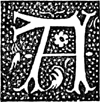 A THIN border, very frequently used in illuminating
by the Italians; consisting of small blue and pink
spaces, ornamented with white lacework over the
flat ground.
A THIN border, very frequently used in illuminating
by the Italians; consisting of small blue and pink
spaces, ornamented with white lacework over the
flat ground.
Fig. 2,
Are specimens of various flowers, ornamentations, foliage, the arabesque scroll, etc., which are to be met with in the ancient manuscripts. To give anything like a variety, would fill a volume; to classify them would also be an endless task, since any contrivance to do so would be fruitless: my object being to give an insight to some of the leading features observable in the illuminations: these are sufficient for the beginner. To acquire an accurate idea, I must refer the student to the British Museum. I have given here outlines of subjects most frequently met with; these the student can fill up with colours according to his taste, varying them at pleasure; yet, in preference, he should endeavour to sketch them himself, since it is desirable that he should acquire proficiency in these trifles, for as they generally form small details, to relieve the solid parts, 84 and are intended to fill up blanks, they invariably require to be well executed.
Fig. 3,
Are compartments to be filled up by various solid colours over which the scrollwork or ornaments are applied, either in white, gold, or colours; when in red, it is called damask-work, the patterns of which can be varied in endless variety. Over the gold, engravings with the agate are highly effective, sometimes forming simple ornamentations, or representing embossed chasing.
Fig. 4,
Represents a portion of a scroll to be filled in by a solid colour, over which, after being properly shaded, fine threads of gold may be drawn, or thinly dotted in white. In making these or similar scrolls, care should be taken that they are gracefully drawn, and made to run freely throughout the design.
Fig. 5,
Illustrates fragments of curves with leaves or ornaments which must be ruled-in with the ruling-pen, by the aid of the wooden scroll, the scroll being placed on the pencil-tracing, where a portion of its curve corresponds with the intended design.
Fig. 6,
Are two straight lines ruled parallel and closely together, so as to show a white thread between.
Is the initial letter O, copied from a woodcut. Though the general design is effective and pleasing, it is not accurately 85 drawn; whereas it might have been, had the designer used the tracing-paper. I have shown the defects in the outline, to illustrate a principle which should be always avoided, viz., disregard for the mechanical appliances, by means of repetition always at hand for the illuminator by using the red transfer paper.
This initial is very useful to copy frequently, since it will give freedom to the hand in producing graceful curves. The remaining figures on this plate are various initials, used at the head of texts; they may be variously illuminated.
Is an early specimen of Byzantine art, about the eighth century, the principle of the Irish school being here adopted, on which the acanthus foliage of the Roman style is superadded. Some gorgeous specimens of this style are in most of the European libraries; but many valuable specimens of that period must have been lost, since the Iconoclastic fanatics destroyed so many thousands by the flames, from the end of the fifth to the seventh centuries.
Is a specimen of a style of illuminating much in use from the thirteenth century to the beginning of the fourteenth. Many and very varied specimens of this style are in almost every collection in European libraries. Sometimes the bands are alternately solid and transparent; in others, the bands assume a lozenge-fashioned, undulated, or circular shape; but another and more frequently adopted mode is to alternate them, tints, of solid coloured bands, keeping up strict regard as to complement of colour. The following order may be regarded as a lesson:—Crimson, gold, ultramarine, and buff may succeed each other. The ornamentations show best on them when relieved, by placing "casting shadows" under the flowers, scrolls, etc.
Is an Italian border of the fourteenth century. The stems of the scrollwork may be, with good effect, painted in gold, and shaded up in burnt sienna, to imitate the bark of trees. Scrolls and foliage may be painted in this specimen in delicate tinted colours, such as greys, light blues, or pinks, softly shaded up, and ornamented with white or gold ornamentations, according to the circumstance of the tint selected. Flowers and leaves, of course, in their natural colours. Various, and always delicate tints for greens in leaves, are essentials in the old Italian border. The "back-ground" here is intended to be gold, though other tints may be substituted, so long as they are not introduced in the ornamentations.
Is a border, to be found in almost every contemporaneous school of the period—the French, the Flemish, the Italian, as well as English and Irish. The ornamentations are not so softly executed, nor is the outline as graceful as in the former. The back-ground is always transparent, containing, sometimes, small figured filigree work. A preponderance of one pervading colour is sometimes its characteristic; but too much similarity in tint should be carefully avoided.
Is the same style precisely as above, with the peculiarity of the ornamentation springing from the immediate border surrounding the text. The grotesque animal, twining itself in a curious manner, is also typical of the illuminations of the twelfth and thirteenth centuries.
"THE MODEL OUTLINE."
I have ventured to give a specimen of a modern style of illumination, based upon no principle whatever which could furnish the student with any instructive hints, or enable him to produce original ideas of his own. As a whole, it represents snatches of ornamentations, jumbled together without order or arrangement, and vanishing at both ends into space.
Scrollwork, having neither beginning, middle, or termination, and presenting a series of flourishes, which may be said to give this class of outline a distinctive character, under the generic title of Sign-boarding. It is an attempt at imitating missal, bearing about the same relation to its prototype as the modern to the pure Gothic in architecture, or the ancient Rome of Augustus to that of the present day in civilisation.
De gustibus non disputandum est.
THE END
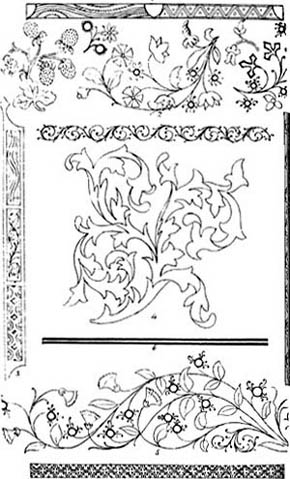
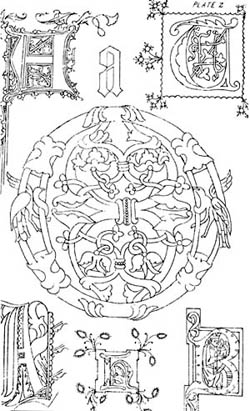
PLATE 2
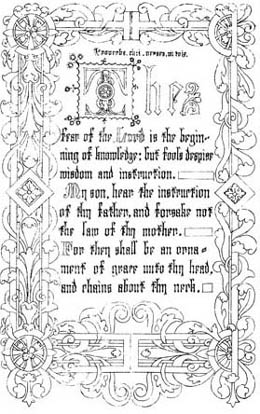
PLATE 3
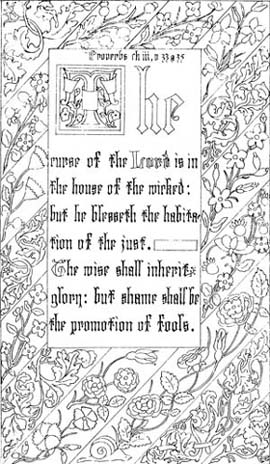
PLATE 4
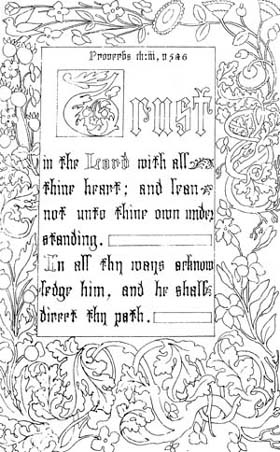
PLATE 5
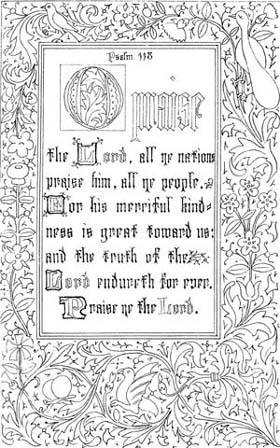
PLATE 6
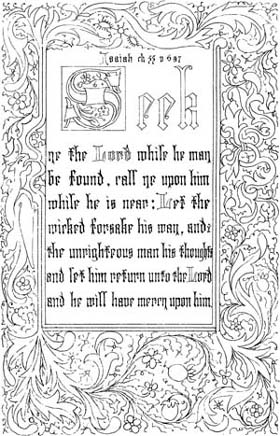
PLATE 7
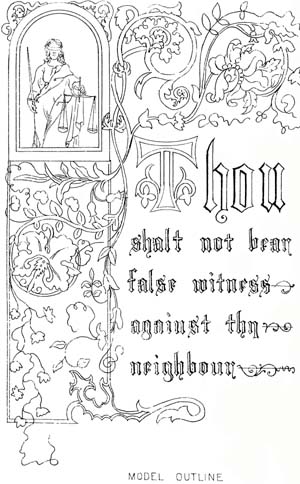
PLATE 8
CATALOGUE
AND
LIST OF COLOURS
OUTLINES, MATERIALS AND PUBLICATIONS,
FOR
Illuminating and Missal Painting.
MANUFACTURED AND PUBLISHED BY
D. LAURENT DE LARA.
(Illuminating Artist to the Queen.)
3, TORRINGTON SQUARE, RUSSELL SQUARE,
LONDON, W.C.
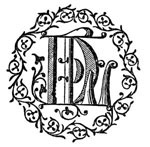
Wholesale Agents for Laurent de Lara's publications,
| Messrs. | MOORE & McQUEEN, Berners-street, Oxford-street. |
| " | ROWNEY & Co., Rathbone-pl. |
| " | REEVES & SONS, Cheapside. |
| " | PENNY & SON, Bow Lane, and Cannon Street. |
| " | HENRY HERING, 137 Regent Street. |
| " | R. ACKERMANN, Regent-st. |
| " | CLIFFORD, Piccadilly. |
| " | BOWDEN, Oxford-street. |
| " | FULLER & Co., Pall Mall. |
| " | DROOSTEN, ALLAN & Co. 126, Strand. |
| " | RIXON & ARNOLD, 29, Poultry. |
| " | JOHN FIELD, Regent's Quadt. |
| " | GALIGNANI, Rue de Rivoli, Paris. |
| " | BUFFA & SONS, Amsterdam. |
| " | NUTNAM, Bowery, New York. |
E. FULLER & Co, 168, Portland Road, N.W.
DESIGNED BY D. L. DE LARA.
| Outlines for Illuminating, in parts of 6 Plain | 6s. 0d. |
| Partially Coloured Nos. | 12s. 0d. |
Or may be had in separate Numbers, Price 1s. Plain, 2s. partly Coloured.
The great demand made for Outlines by the daily increase of the chaste and beautiful Art of Illuminating, originally induced their publication by Mr. De Lara, and, although he has numerous imitators he confidently recommends them to the notice of the Public, both as aids and instructors in the study of Missal Painting; every care having been taken faithfully to reproduce for the Student's enlightenment, adaptations of the style of the best and purest Masters.
☞ Title and Presentation Plate may be had to complete this Series; or, elegantly bound in cloth, antique gilt. Dedicated to Viscountess Combermere, with Title and Presentation Plate. Plain 25s., partially Coloured, 45s. Published by Longman, Green, Longman, and Roberts.
SCRIPTURAL TEXTS AND CROSSES.
Half Sheet Imperial.
"Glory to God in the Highest," etc.
"Behold I bring you good tidings," etc.
Two Christmas Texts, plain each 2s. 6d., and 4s. part Coloured.
LONG TEXTS, 28 BY 7 INCHES.—PLAIN 1s. 6d. COLOURED 3s.
SMALL TEXTS, 21 BY 6 INCHES.—PLAIN 1s. PART COLOURED 2s.
SQUARE TEXT.—PLAIN 1s. 6d. PART COLOURED 3s.
Crosses, 4to. Imperial 1s. 6d. plain, 3s. part Coloured.
Fourth Series, Quarto Royal, 1s. plain, 2s. part Coloured.
THREE SACRED MONOGRAMS, 1, 2 AND 3; AND THREE CROSSES, 1s. AND 2s. PLAIN AND COLOURED.
Illuminated in Chromo-Lithography, Half Sheet Royal, in Gold and 10 Colours, Price 5s. each.
THE LORD'S PRAYER, and
THE CREDO. From an old Psalter of Henry VIII., in the collection of E. Offor, Esq. (Dedicated by permission to Viscountess Forbes), and published by Henry Hering, (Late Hering & Remington), 137, Regent Street.
The Same Subject in outline, price 1s. 6d. plain, and 3s. partly coloured.
ALSO
THE TEN COMMANDMENTS, 4to Imperial. An original design, richly illuminated in Chromo-Lithography, price 5 s. (Dedicated to her Majesty the Queen.)
Outlines of the above, 4to Imperial. 2s. plain, and 3s. 6d. partly Illuminated.
AND THE
ROYAL CHESS BOARD. In Outline 22½ inches square, with Four Illustrations, viz.:—"First Move," "Stale Mate," "Check Mate," and "Mated." Price, 5s. plain, 8s. partly coloured, and on the finest Italian Vellum, 31s. 6d.
SHEET OF FIFTEEN BOOK-MARKERS. 4to Imperial, with Scriptural Mottoes, 5s. plain, and 8s. partially Illuminated.
SHEET OF MEDIÆVAL ALPHABETS, 4to Imperial, 1s. plain, 3s. 3d. partially Illuminated.
THE PRIZE "BEATITUDES," for 1860. (Outlines) awarded by the I. A. U. L.
THE ADORATION OF THE MAGI. 4to Imperial. (A splendid Missal with 12 figures). 2s. 6d. plain, and 4s. part Coloured.
☞ All the above Subjects are also published on the finest Italian Vellum, from 8s. to 10s. 6d. each.
The following Illuminations, executed by Lady Artists, are ready for Sale or hire.
| s. d. | ||
| Thompson's Seasons—Two Subjects | each 12 0 | |
| The Lord's Prayer | 14 6 | |
| The Creed | 14 0 | |
| Two Subjects of the 119th Psalm | each 14 0 | |
| By Mrs. Davidson. | ||
| Two Subjects of the 119th Psalm | each 12 0 | |
| The Poppy Flower, and Cherry Border | 12 0 | |
| By Miss Webb. | ||
| "Nunc Dimittis," St. Luke | 12 0 | |
| Poesy | 10 6 | |
| Praise—Psalm 146 | 7 0 | |
| By Miss Saunders. | ||
| The Adoration of the Magi, and St. John | each 14 0 | |
| David with the Head of Goliath | 10 6 | |
| Alphabetical Letters, by various Artists, from 3s. to |
8 0 | |
| By Miss Thompson & Miss Peet. |
And other Subjects from Psalm CXIX., &c., &c., are in progress, and may be always had.
Plain 9d.; Partially coloured, 1s. 6d. each.
Or in Handsome Wrappers containing Eight Subjects.
6s. and 12s.
These "Miniature Outlines" are so delicately executed, and in detail so perfect, that they afford the Student an admirable opportunity of acquiring a most delicate touch before venturing on the larger subjects; and the universal satisfaction they have given, has induced Laurent de Lara to re-produce the whole of his numerous publications in this form. At the same time he most earnestly enjoins the Student not to use other than "Cake Illuminating Colours" in these, as indeed in all Illuminations where delicacy and effect is desirable.
THE "BEATITUDES," (Eight Subjects.) Fac-simile, half the size of the 4to Royal.
The Same Subject, one sixth the original size, 6d. and 1s. each.
THE LORD'S PRAYER; THE CREDO.
from an old Psalter of HENRY the VIII.
4to. Imperial drawing boards, 1s. plain, 2s. coloured.
The Same Subjects, one sixth, 9d. plain, 1s. 6d. coloured.
Subscribers are entitled to two Illuminations at a time, to be exchanged for fresh subjects, as frequently as desired.
Terms of Subscriptions.
Annually £4 4s. 0d.
Half Yearly £2 12s. 6d.
Quarterly £1 11s. 6d.
A Select assortment of Vellum Illuminations are constantly kept in stock for sale or hire, of which pencil outlines are published at 6d., 9d., 1s., 1s. 6d., & 2s. each.
THE LORD'S PRAYER, 4to. Imperial, 4to. Royal, Miniature, and small Miniature. Two designs.
THE APOSTLES' CREED, ditto. Two designs.
SONNET.—"It is a Dream."
DAVID WITH THE HEAD OF GOLIATH.
THE 67th PSALM.
SMALL CREDO.
THE 119th PSALM. Twenty-two Subjects, with Title and Presentation Plate.
THE SERMON ON THE MOUNT. Twenty-two Subjects, with ditto.
THE ADORATION OF THE MAGI.
ST. JOHN WRITING THE GOSPEL.
POESY. Sonnet.
THE PROVERBS, Alphabetically arranged. Large text 24 subjects.
THOMPSON'S SEASONS. (Two Subjects).
THE COMMANDMENTS. (Dedicated to her Majesty).
THE COMMANDMENTS. (Byzantine School).
THE "BEATITUDES." (Eight Subjects, complete).
THE PRIZE "BEATITUDES." (Three Subjects), awarded by the I. A. U. L. for 1860.
MEDIÆVAL ALPHABETS, 4to. Imperial.
25 DIFFERENT BOOK-MARKERS, 10 for the reception of Photograph vignettes. Small and large size.
THE ROYAL CHESSBOARD. Folio Imperial, 22½ inches square.
18 DIFFERENT CROSSES.
18 SUBJECTS FROM "SHAKSPEARE." (Quite new).
The necessity for improvements to be made in the Ordinary Water Colours, too often palmed off on the unwary by Artists' Colourmen, has induced Mr. de Lara to give the Subject his most earnest and careful attention, and as a result, they have acquired a reputation for the richness and brilliancy of their Tints, surpassing even those manufactured in Paris; and their peculiar fitness when applied to Illuminating on Vellum, or for Miniatures, proves them, in these respects, to be unrivalled.
THE TWENTY FIVE SHILLING BOX
CONTAINS
Twelve Colours, Gold and Aluminium Shells, Enamel White, Agate Burnisher Pencils, Sable Brush, Parallel Rules, Ruling Pen, Compasses.
THE GUINEA & A HALF BOX
CONTAINS
Eighteen Colours, Gold and Aluminium Shells, Enamel White, and fuller fittings than above.
THE TWO GUINEA BOX
CONTAINS
Fourteen Double and Four Half Cakes, Gold and Aluminium Shells, and complete Fittings.
THE TWO GUINEA & A HALF BOX
CONTAINS
Eighteen Whole Cakes, and additional materials.
THE THREE GUINEA BOX
Same Colours and superior and additional Fittings.
In calling the attention of the Public to this Box, D. Laurent de Lara feels it incumbent on him to remark, that whatever costliness and expense may be bestowed on material, nothing further is required for the successful practising of this Art.
Illuminating Box of Moist Colors for Fruits and Flowers, 12s. 6d. each.
Box of Opaque Tints, 12s. each.
ALWAYS ON HAND
An Assortment of Prepared Italian Vellum, ready Mounted, 3s. 6d., 6s., and 8s. each. Whole Skins from 7s. 6d. to £3 3s. each.
GOLD, PLATINA, AND ALUMINIUM SHELLS, 10s. 6d. PER DOZEN.
Best Water Gold-Size in Pots 2s. each, for raised Gilding.
Real French Tracing Paper, 1s. 6d. the Sheet.
MATHEMATICAL INSTRUMENTS 21s. OR 31s. 6d. THE CASE.
⁂ Instruction in the Art of Illuminating by personal Lessons or by correspondence—the Course, £3 3s.—with employment afterwards, if desired by special contract.
WILL BE REPUBLISHED FOR THE FORTHCOMING SEASON,
DEDICATED TO
VISCOUNTESS COMBERMERE,
WITH PRESENTATION AND TITLE PLATE.
| Partly Illuminated and handsomely bound | £2 5 0 |
| Plain Ditto | 1 5 0 |
LONDON:
LONGMAN, GREEN, LONGMAN, ROBERTS AND GREEN,
PATERNOSTER ROW,
AND ALL BOOKSELLERS.
JUST PUBLISHED
MISCELLANEOUS PIECES,
Plain 1s. 6d.; part Coloured 3s.
12 Nos. OF THE ROYAL PSALTER,
DEDICATED TO THE
(COUNTESS DOWAGER OF LICHFIELD.)
Adapted from the famous missal the Hours of Anna of Brittany.
(Floral and Fruit Borders.)
"A SWARM OF BEES WORTH HIVING, OR BEES WITHOUT STINGS."
"GIVE ALL THINE EAR, BUT FEW THY VOICE,"
(from an old book in the Stow Library) dedicated to the late Marquis of Breadalbane.
TWO SUBJECTS FROM ISAIAH LIII.
1s. 6d. and 3s. each.
Published on the 10th of March, 1863, on the occasion of the Marriage of H.R.H. the Princess Alexandra and the Prince of Wales.
Price 1s. 6d. and 3s. part Coloured.
THE ROYAL MONOGRAM AND CORONET,
AND THE ODE
"HAIL ALEXANDRA, STAR OF DENMARK," ETC.,
(Poetry and Designs by D. Laurent de Lara.)
The originals of these beautiful and characteristic designs, were presented to Her Royal Highness the Princess of Wales on the occasion of her marriage.
Completely Illuminated price £2 2s. each.
JUST PUBLISHED.
"THE BEAUTIES OF SHAKSPERE,"
BEING CHOICE EXTRACTS OF THE GREAT DRAMATIST, PICTORIALLY ILLUSTRATED, CONTAINING TEXT IN THE CENTRE.
First Series, 6s. plain; 12s. partly illuminated.
Six Subjects from the "Tempest."
| 1. | CALIBAN. | "I'll shew thee the best Springs." |
| 2. | FERDINAND. | "My Spirit as in a Dream," etc. |
| 3. | PROSPERO. | "Hast thou, which art but air." |
| 4. | VANITY OF HUMAN NATURE. | "The Cloud capp'd Towers." |
| 5. | ARIEL'S SONG. | "Where the Bee sucks," etc. |
| 6. | DO. DO. | "Full fathom five thy Father lies." |
Second Series, 6s. plain; 12s. coloured.
Six Subjects from the "Merchant of Venice."
| 7. | SHYLOCK. | "If it will feed nothing." |
| 8. | BASSANIO. | "In Belmont is a lady." |
| 9. | LAUNCELOT GOBBO. | "Well, if any man in Italy," etc. |
| 10. | THE PRINCE OF MOROCCO. | "What have we here, a Carrion's death." |
| 11. | ANTONIO. | "I am armed and well prepared." |
| 12. | PORTIA. | "The quality of mercy is not strained." |
Six Subjects from "Hamlet."
| 13. | POLONIUS. | "Give every man thine ear." |
| 14. | OPHELIA. | "O, what noble mind is here overthrown." |
| 15. | HAMLET'S SOLILOQUY. | "To be or not to be." |
| 16. | INTERVIEW. | "Ecstasy." |
| 17. | HAMLET. | "Alas! poor Yorrick." |
| 18. | GRAVE-DIGGERS. | "Who builds stronger than a mason." |
This beautiful publication of which already three successive editions have been issued, will be followed by "As you like it" and other popular Plays, at short intervals.
Which are strongly recommended for their brilliancy of Tint, may be had separately or in
Boxes price 21s. and 42s.
Gold, Silver Aluminium, and Platina,
In Shells, Saucers, and Cakes.
A large assortment of the best Prepared Drawing Vellum.
Vellum Paper, and the best Drawing Boards.
TRACING AND TRANSFER PAPERS.
A GREAT VARIETY OF
Laurent de Lara's Outlines for Coloring Scrolls and Texts,
WITH
The best Works of Instruction.
BOOKS OF ALPHABETS AND ALL ILLUMINATED WORKS.
GOLD SIZE,
AND ALL ARTICLES CONNECTED WITH THE
Art of Illuminating and the Fine Arts.
191, REGENT STREET, W.
Catalogues by post, free on application.
JAMES NEWMAN,
MANUFACTURER OF
Illuminating Colours in Oil or Water.
Boxes of Colours fitted up with Burnishers, Brushes, Shells, &c., very complete.
PURE GOLD AND ALUMINIUM POWDER IN SHELLS, HALF SHELLS, OR
CAKES, LIKE WATER COLOURS.
Prepared Vellum and every Article used in Illuminating.
ORNAMENTAL ALPHABETS AND WORKS ON ILLUMINATING
BODY COLOUR WHITE.
Sizing preparation to prepare the Surface of many Materials and give hardness to the Colours.
See NEWMAN'S Harmonious Colouring, &c., Price 1s.
NEWMAN'S SUPERFINE WATER COLOURS.
Newman's Improved Moist Colours & Chinese White.
MANUFACTURER OF
Every Description of Artist's Materials of the Best Quality.
24, SOHO SQUARE, LONDON, W.
Water Colours Prepared for Illuminating, in Cakes or Moist in Pans, Half Cakes or Half Pans.
Whole Cakes, 1s., Half Cakes, 6d. each.
Whole Cakes, 1s. 6d., Half Cakes, 9d. each.
Whole Cakes, 2s., Half Cakes, 1s. each.
Whole Cakes, 3s., Half Cakes, 1s. 6d. each.
Whole Cakes, 5s., Half Cakes, 2s. 6d. each.
Whole Cake, £1 1s., Half Cake, 10s. 6d., Quarter Cake, 5s. 6d. each.
Powder Colours for Illuminating,
In Bottles,
Ready prepared for use with the admixture of Water only.
Prices same as Whole Cakes.
Boxes of Colours for Illuminating and Missal Painting.
Half-Guinea Box.
French Polished Mahogany Slide-top Box, containing Six Half Cakes of Colours—Crimson Lake, Scarlet Vermilion, French Ultramarine, Emerald Green, Pale Chrome, and Burnt Sienna, Tube of Enamel White, Gold and Aluminium Shells, Four Siberian Brushes, Burnisher, and Indian Ink.
One Guinea Box.
Mahogany French Polished Lock Box, containing (in a Japanned Tin Box) Crimson Lake, Scarlet Vermilion, Cobalt, French Ultramarine, Cadmium Yellow, Lamp Black, Emerald Green, Burnt Sienna, Bottle of Enamel White, Prepared Gum Water, China Slab, Water Glass, Liquid Ox Gall, Saucer of Gold, Saucer of Aluminium, Agate Burnisher, Cumberland Lead Pencil, Sable Brushes, and Gummed Gold Paper.
One Guinea and a Half Box.
Mahogany French Polished Lock Box, containing (in a Japanned Tin Box) Crimson Lake, Scarlet Vermilion, Cobalt, French Ultramarine, Cadmium Yellow, Lamp Black, Emerald Green, Burnt Sienna, Rose Madder, Gamboge, Vandyke Brown, and Pale Chrome Yellow, Bottle of Enamel White, Prepared Gum Water, Liquid Ox Gall, Gold Ink, Saucer of Gold, Saucer of Aluminium, China Slab, Water Glass, Pot of Water Gold Size, Agate Burnisher, Cumberland Lead Pencil, Six Sable Brushes, and Gummed Gold Paper.
Materials for Illuminating and Missal Painting.
Two Guinea Box.
Mahogany French Polished Lock Box, containing (in a Japanned Tin Box) Crimson Lake, Scarlet Vermilion, Cobalt, French Ultramarine, Cadmium Yellow, Lamp Black, Emerald Green, Burnt Sienna, Rose Madder, Gamboge, Vandyke Brown, Pale Chrome, Carmine, Green Oxide of Chromium, Permanent Red, Brown Madder, Lemon Yellow, and Violet Carmine, Bottle of Enamel White, Prepared Gum Water, Liquid Ox Gall, Gold Ink, Saucer of Gold, Saucer of Aluminium, Six-Division China Slab, Water Glass, Pot of Water Gold Size, Agate Burnisher, Cumberland Lead Pencil, Eight Sable Brushes, and Gummed Gold Paper.
Three Guinea Box.
Rosewood Caddy Lid French Polished Box with Plated Fittings, containing Colours, &c., as above, and a most complete Set of Materials.
| s. d. | ||
| Prepared Enamel White, in bottles | each | 1 0 |
| "Indian Ink | " | 1 0 |
| "Liquid Brown | " | 1 0 |
| "Liquid Carmine | " | 1 6 |
| "Liquid Ox Gall | " | 1 0 |
| "Gold Size, in pots | " | 1 0 |
| Raising Preparation, in pots | " | 1 0 |
| Prepared Strong Clarified Gum Water | " | 6d. & 1 0 |
Gold, Silver, Aluminium, &c.
| s. d. | ||
| Gold Leaf, per Book of 25 Leaves | 1 9 | |
| Silver Leaf, per Book of 50 Leaves | 1 9 | |
| Gold Paper, Adhesive on back | per Sheet | 3 6 |
| Dittoditto | per ½ Sheet | 1 9 |
| Dittoditto | per ¼ Sheet | 1 0 |
| Ditto, in packets | per packet, | 6d. & 1 0 |
| Gold in Cakes | each | 5 0 |
| Aluminium ditto | " | 1 0 |
| Gold in Saucer | each | 6d. & 0 9 |
| Aluminium ditto | " | 0 4 |
| 102 Gold, in Shell | each | 8 |
| Smaller ditto | " | 6 |
| Green Gold | " | 8 |
| Platina | " | 8 |
| Aluminium | " | 4 |
| Silver | " | 4 |
Gold and Silver Ink.
| s. d. | ||
| Liquid in Bottles | each | 1 0 |
Bessemer's Gold Paint.
| s. d. | ||
| Gold Paint and Preparation, large size | each | 4 0 |
| Ditto, small size | " | 1 6 |
| Preparation only, large size | " | 0 6 |
Bronzes.
| s. d. | ||
| Finest Deep and Pale Gold, Silver, Copper and Green Bronzes |
per packet | 2 0 |
| Common Gold Bronze | per bottle, 6d & | 1 0 |
Prepared Vellum.
PRICE ACCORDING TO SIZE.
Small Agate Burnishers.
Albata Ferrules and Black Handles, various patterns each 2 0
A LARGE ASSORTMENT OF OUTLINES, COPIES, AND BOOKS ON ILLUMINATING ALWAYS IN STOCK.
De Lara's Series of Outlines and Publications, for which see his List.
Illuminating Art Union of London
(INSTITUTED 1857.)
For promoting and encouraging the Mediæval Style of Illuminating on Vellum, adaptable for Modern purposes, either sacred or secular, to hold Annual Exhibitions and distribute prizes for original designs, and to afford employment to the educated gentlewomen of limited means.
Annual Subscription £1 1s.
For which an "Original Vellum Illumination" executed by the less affluent Members, will be presented annually to the Subscribers.
Life Members £12 12s.
Patronesses.
Honorary Secretary.
MRS. FABER.
Honorary Treasurer.
CHARLES BOARD, Esq.
Manager.
D. LAURENT DE LARA, Esq.
Prospectuses and Reports may be had of D. Laurent de Lara, Manager, 3, Torrington Square, Russell Square, W.C.
LIST OF
COLOUR BOXES AND MATERIALS,
PREPARED BY
GEORGE ROWNEY & COMPANY,
FOR
Illuminating & Missal Painting.
15s. Mahogany Box,
CONTAINING
Cobalt, Prussian Blue, Emerald Green, Chrome 2, Crimson Lake, Vermilion, Gold and Silver Shells, Agate Burnisher, and Three Sable Brushes.
21s. Mahogany Lock Box,
CONTAINING
Cobalt, Fr. Ultra, Emerald Green, Sap Green, Chrome 2, Chrome 4, Crimson Lake, Madder Lake, Lamp Black, Vandyke, Vermilion, and White, Gold, Green Gold, and Aluminium Shells, Agate Burnisher, Sable Brushes, &c., &c.
31s. 6d. Caddy Lid Box,
CONTAINING
Cobalt, Fr. Ultra, Emerald Green, Sap Green, Chrome 1, Chrome 3, Dragon's Blood, Vermilion, Yellow Oker, Lamp Black, Violet, Carmine, Rose Madder, Carmine, Bt. Carmine, Bottle of Chinese White, Gold, Green Gold and Aluminium Shells, Gold Leaf, Agate Burnisher, Dividers, Sable Brushes, Pot of Water Gold-Size, &c.
2 Guinea Caddy Lid Box with Drawer,
CONTAINING
Cobalt, Fr. Ultra, Emerald Green, Sap Green, Chrome 1, Chrome 3, Gamboge, Yellow Oker, Bt. Sienna, Vandyke, Sepia, Lamp Black, Crimson Lake, Scarlet Vermilion, Rose Madder, Purple Madder, Madder Brown, Carmine, Bottle of Chinese White, Pot of Water Gold-Size, Two Shells, each as above, Gold Leaf, Extra Brushes, &c.
3 Guinea Rosewood, Caddy Lid,
CONTAINING
besides the above Eighteen colours, Prussian Blue, Violet Carmine, Cadmium Yellow, Mars Orange, Bt. Carmine, Deep Rose; and every article necessary for all descriptions of Illuminating.
Boxes may be obtained, fitted to any arrangement required. A large assortment of Laurent de Lara's outlines, plain, or partly coloured either on fine Card or Vellum.
GEORGE ROWNEY & CO.,
MANUFACTURING ARTIST'S COLOURMEN,
51 & 52, RATHBONE PLACE,
LONDON.
[A] Vide list of materials at the end of the book.
[B] A contemporary has asserted, that "vermilion" and "white" should not be mixed; he says: "The vermilion must not be mixed with white, or it will lose its brilliancy, and become a colour like brickdust." I know not what vermilion or white he used to induce him to come to this conclusion, but, after an experience of many years, I assert, that if the proper illuminating colours are used, they will, in combination, form that beautiful "salmon tint," so frequently to be found in the old missals.
[C] Or with one of Gillott's fine Lithographic Pens.
[D] I have prepared a variety of drawings of initial letters, and classical borders both on vellum and cardboard, with accompanying outlines of the same, very faintly lithographed, on super-fine drawing-boards which may be purchased for a trifling expense at most art repositories and booksellers. The illuminations may also be purchased, or are lent on hire, for the purposes of copying. These are executed under my direction and superintendence, by my numerous pupils, who now follow out the art as a lucrative profession. As the student will obtain better and more accurate ideas of copying from drawings than from prints, I have, at the suggestion of many of my friends, adopted this plan of supplying the amateur artist with an illuminated copy, and its outline, which he may easily fill up according to his own taste, or strictly follow the original: the encouragement this suggestion has received from the public has tended to confer a great boon on a worthy class of female artists, who have been zealous and successful in a beautiful branch of female accomplishment.
[E] Some eminent writer on "ornamental art" strongly objects to introduce "casting shadows" in ornamentations, or in other words bringing out objects in "relief,"—he argues, with some apparent plausibility, that if treading on a carpet, where flowers or scrollwork were introduced, he should be afraid of crushing the flowers, or stumbling over the ornamentations. I know not which to admire most, the pedantry of modern philosophy on art, or the actual beauty displayed in the "Old Missals," in which these charming "casting shadows" present such bewitching reality to the imagination. I leave the question to be answered by the untutored beholder, without venturing on any theory of my own.
[F] 8s. plain, 16s. partly coloured.
[G] This Song published and set to Music, by H. Von Hoff, words by Laurent de Lara.
Clear printer's errors were corrected, but original spelling was not modified or harmonized.